#that ive now learned to combine and feel at the same time
Explore tagged Tumblr posts
Text
⋆.ೃ࿔*:・ in your mind (mattheo riddle x fem! reader)
summary : mattheo riddle, your sworn enemy, forgets about your ability to hear others thoughts





mattheo fucking riddle, waltzes into the class as if he owns the place. that stupid smirk and knowing eyes that he could do anything for salazars sake and not get into any trouble. flitwicks dismay is obvious, yet he does nothing but instruct riddle to take a seat just behind you. now your dismay was obvious, riddle had been your sworn enemy for as long as you could remember however you couldn’t really remember why.
‘oi y/l/n, what’re we doing?’ riddle questions you. ‘come on time and focus to find out’ you respond and for some odd reason there was no sarcastic comment or any insult thrown your way. just silence from mattheo. despite your normal dislike for your abilities to hear other’s thoughts, you used it. just this once.
voices boomed and echoed through your head, clashing together and combining until you focused in on one particular annoyingly attractive voice. ‘god why does she have to be so pretty’ you hear from the same voice that had called you a multitude of opposing mocks. surely he wasn’t talking about you. ‘her hair is so gorgeous, looks so soft, i just wanna play with it ugh.’ to confirm you weren’t dreaming, you dropped your pencil and turned your head. all you saw was his dark, rich brown eyes completely focused on you.
‘i always forget how beautiful her eyes are, this lighting doesn’t do them justice.’ and there was your confirmation.
for the rest of the lesson, you couldn’t focus on the work only on the handsome yet annoying boy behind you who hadn’t stopped thinking about you. as the bell rings you shove your items away in a haste determined to learn more about this admiration for you. the halls become flooded with kids rushing to get to their dorms or the hall for a quick snack before dinner yet all you were focused on was mattheo riddle.
he turned into a quiet hallway and you followed suit, your presence becoming known to him. ‘what are you doing here?’ he asks with irritation in his voice, a very fake irritation as all he could think about was ‘i want her so bad’. you walked closer towards him with a small smile plastered on your face, almost chest to chest and whispered the words, ‘for being someone you hate, i’m sure on your mind a lot’.
a blush rose to his cheeks, ‘i don’t know what you’re talking about.’ a continuous, ‘fuck fuck fuck, i forgot she can hear peoples thoughts’, jostled through his mind. a small giggle arose from your sweet lips and that’s all it took for mattheo to completely fold. ‘christ all right, you caught me’ he started, ‘im like head over heels for you, even with our little fights it makes me fall more in love with you every single time. you’re just so gorgeous and so kind, the complete opposite to me yet im totally obsessed with you.’ a smile that you had never seen before appeared on his face.
you were in complete shock, this was almost the last thing you expected from him of all people. mattheo riddle. yet you couldn’t ignore the way your stomach exploded in flutters by his words and how you suddenly became speechless. ‘can i kiss you’, you uttered out after moments of silence. ‘please.’

author note : i feel like this may be the most common thing ive ever wrote but hey it’s common for a reason so live laugh love i guess. and as always requests are still open!!
word count : 557
661 notes
·
View notes
Note
do you happen to have any suggestions for ways to do actual helpful things in ways that are safe for high risk ppl? none of the communist or anarchist groups in my area will run HEPA filters or have events outdoors, ive asked so many organizers and they all just say no that's not something we want to do, so i haven't been able to get involved in... literally any left stuff bc im high risk. if there's tricks to convincing people to run HEPAs that i don't know abt or advice for how to be politically involved without leaving the house id really appreciate it, ive felt really lost and like im a bad person ever since 2020 bc of this, i can't be complicit in this society but idk how to actually do things to make me not complicit bc all the suggestions i see online involve other ppl, and other ppl locally won't do things to make it safe for me to be in the same space as them. i just don't know what to do with that bc i feel like i might genuinely be a bad person for not doing anyhting to fight society, and disability is no excuse for being a bad person who accepts society, but also, i don't want to die of covid and i already got it once and it ruined my health even more and now i have days i can't leave bed at all and i don't want that to get worse, idk. but i agree that it's bad to be mostly online and ppl who don't leave the house aren't really leftists and are part of the problem, like ik how i deal with being disabled makes me part of the problem in society, so it's just rlly hard to figure out what to do or if there's any hope for me.
Some time ago someone asked me what I can recommend they, a disabled person, can do to get involved and I told them to learn to relax, and this is a reason why, friend.
You're not a bad person for not having your needs met when trying to organize. You're not a bad person for fearing covid and a ruined health. This world is not for us, why should we feel shame it doesn't make space for us? It is not our fault.
But, yes, here is where we come back to the question of what can we do, but first we have to sit with feeling comfortable in our relative inaction; if we do not appreciate our abilities and capacities as they exist we run the risk of being used and manipulate by others with political agendas and this is true even of fully able folks, of people who are run ragged in political parties by leaders because they are guilt-tripped into over-extending themselves 'for the cause', 'for the party', 'for the movement', etc.
Without taking proper stock of your own abilities and worth you run the risk of being used as a tool by others. So you must appreciate what you can and can't do, to the extent you can or can't do it and learn to set that boundary before getting into actions and having it set for you, but not by you.
Your ask worries me because your shame or your guilt combined with your zeal is ripe to be misused by others. You have nothing to feel guilty for, friend. Appreciate yourself, as you are, and then look for activities you can do. There's an order of operations to maintain.
Guilt is unworthy of us.
We are not complicit even if we partake, we rebel because we refuse to be complicit.
If you want some ideas, try writing to prisoners, making pins/ posters/ stickers/ patches/ etc. in solidarity with movements you are passionate about. It's okay to be online too, y'know?
The revolutionary bar is never so high as to eliminate people from revolutionary struggle.
I will put in my praxis tag where you can look for more ideas.
225 notes
·
View notes
Text
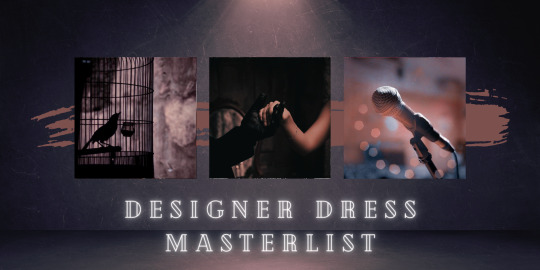

prologue
You’ve never been inside the famous club, The 141.
i. it's a new day, it's a new life
This isn’t where you expected to end up—stuck in some rundown motel with nothing but the clothes on your back.
ii. a collection of strangers (a series of secrets)
You can only describe them the same way you can the rest of the club’s workers—stunning.
iii. no proof except my silver tongue
You’ve never been to this side of town at night.
iv. the night was young (and so were we)
Surveying the competition turns out to be code for going on a club crawl and getting obscenely drunk.
v. she works hard for the money (so you better treat her right)
You don’t know what to expect from shopping with Valeria.
vi. would you give the devil this dance
You can’t let yourself be haunted by your past forever, and, unsure as you are, you know one thing to be true: You’ve never felt safer than you do around him.
vii. wise men say, only fools rush in
In the following weeks, you learn one very important thing: John Price is a relentless flirt.
viii. but i can't help failing in love with you
You don’t know how you feel as you kiss him. It’s a combination of emotions you haven’t felt in so long: relief, desire, comfort, joy. They all swirl together into the one emotion you’ve been chasing since your wedding. Safe.
ix. the rumor burned straight through the town (and as it grew, so did her vow)
Kyle doesn’t think much of you the day you first walk into the club.
x. everybody thought the truth had been caught (her reputation began to drown)
You haven’t looked at your wedding photo in years.
xi. screaming birds sound an awful lot like singing
Everything you’ve experienced in the past four months pales in comparison to how your heart shatters at this moment.
xii. it won't cost you much (just a single drop of blood)
Who knew rock bottom looked like standing before a wall of mirrors in a bespoke wedding gown?
xiii. little girl gone
You’re shocked into consciousness, startling awake in a pile of plush blankets and cloud-soft pillows.
xiv. nothing makes me weak now (you better run for your life)
The news of Price’s arrest—of your alleged murder—sends you into a state of shock.
xv. won't forgive what you did (i've never hurt anyone, now it's time)
They float somewhere between too compliant and too afraid, like they’re scared you may snap at any given moment. Whether they worry it’ll be in anger or anguish, you don’t know. Price is the worst of them all.
xvi. what you'll see is the worst me (I will ask you for mercy)
The nights are the hardest.
xvii. for if i'm going down i guess i'll take you with me
By the end of the week, the plan is set.
xviii. i'm free darlin' (i revenge, i revenge)
Your world is engulfed in fire and blood.
epilogue. it's a new dawn, a new day, a new life (and i'm feeling good)
The beginning of the rest of your life starts with a single, admittedly awkward, therapy appointment.

Extras
karma is a cat purring on my lap
The cat is a wretched creature made of a vicious hatred that could rival only the Devil himself.
my personal hcs for canary
canary's dresses
canary's wedding dresses
canary and adler headcanons
how the 141 makes their money
how the gangs run their businesses
random designer dress headcanons
alternate ending ideas
songs used for chapter titles
soap hcs + canary and price children hcs
canary + 141 age headcanons
#modern warfare masterlist#fic masterlists#captain john price x reader#captain price x reader#john price x reader#price x reader
756 notes
·
View notes
Text
follow up to this ask! this time im just gonna be talking about my coloring process (i also want to let you all know that im not an expert in color theory since im still learning, im quite literally just going random bullshit go on the blending modes 💀 lots of explanation under the cut)
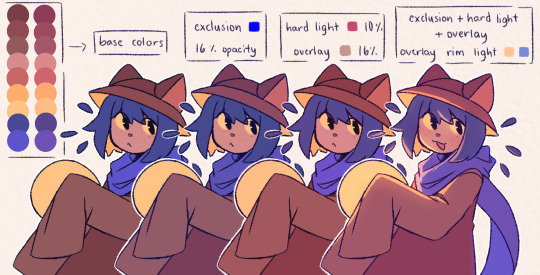
the three blending modes i mainly use are exclusion, hard light, and overlay. from the guide above you could see how the blending modes work on their own, and how they look like combined altogether. the cool thing about blending mode layers is that it really is all about experimentation and finding the best combination for a piece (also to any fellow inabakumori enjoyers GRAHH lagtrain pose jumpscare)
i went through a bunch of blending mode phases before i ended up with those main three, though it's funny how ive been using the same overlay color for about 4 years now (multiply used to be one of them, and i still use it from time to time, just not as much). im gonna be honest the whole reason why i know about blending modes being helpful was because one time i accidentally had the fill bucket on and had a certified eureka moment 😭
the best way i could explain these three modes is:
exclusion - honestly i still dont understand how it works either 💀 when i use a really saturated blue color and lower the opacity, it gives a cooler feeling to the palette. feels like a mix of multiply and overlay with how it adjusts the colors without making it darker
hard light - gives more saturation and color
overlay - gives off a glowy effect, especially if the lineart isnt completely solid (this is why it isnt clipped on the folder as shown in the example below, keeping it above the layers gets that glowy effect)
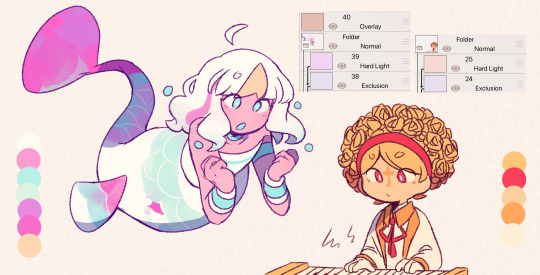
i still use the same colors for exclusion and overlay (while i do alter them with hue saturation brightness from time to time, i just use the same blue and brown for most of my works) though hard light is what i use to make drawings lean towards a temperature
i tend to use warm colors a lot because i think theyre neat and also im biased sorry <3. as a warm palette example, i drew yinu and used this orange color on hard light and lowered the opacity
cold colors have a similar process, it's just the matter of adjusting the hard light layer. i wouldnt really say it's completely cold since i still add warm colors because im still biased </3. as a cold palette example, i drew sayu and used this purple-pink (??) color with the same settings
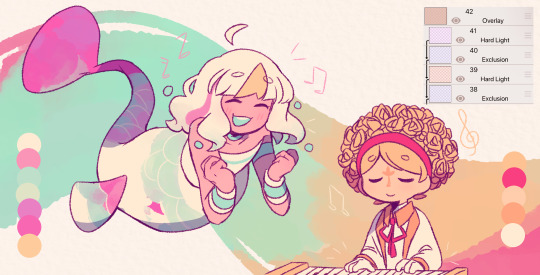
when it comes to drawings that have characters with contrasting palettes, it does take a bit of trial and error but i most of the time i mix both warm and cold methods like the example above. this also helps for art with several characters in general, since the blending modes help make the colors go well together despite the variety
theres also instances where i dont always use the warm + cold combo, since sometimes drawings lean towards a specific temperature instead (like environments with set lighting/shading, so usually i follow that even with characters with different palettes)
tldr; there are lots of palette combos you could make, not necessarily with just the three blending modes i mention. random bullshit go genuinely helps with experimenting with colors!!
#chiimo art shenanigans#uhhhh should i tag the fandoms these characters are from#fanart is fanart ig???#oneshot#oneshot niko#no straight roads#nsr#chiimo ask shenanigans
143 notes
·
View notes
Note
(you right anon)
happy to hear u liked my musings! i really like the way u described gihun as heat, openly passionate, with his intentions clear and pointed; and inho as his natural opposite, deceptive and murky, cold, detached etc they really are two threads in the same stitch
and of course your inclusion of jungbae and youngil as well as sangwoo!! if any man could pull off being jealous of himself its hwang inho. he can tongue at the scar left by the tracker gihun cut out and burn about it while gihun calmly tells him about other little scars left on his body left behind from his childhood, from nights spent at the racetrack or bars or anywhere else inho was not privy to, a different softer sweeter gihun existing within the current man before him
and the idea that gihun wants inho to lose it, to be passionate, to be angry to show SOMETHING human, raw and sticky and bloody is so so fun. show me jealousy and grief, show me hatred in those eyes of yours, don’t look away from this or me, take the mask off, dont lie, i will crack you open and eat your softness etc
love the idea that they both want understanding from the other, and that they long to be equal. they’re darkness chasing light, light chasing darkness.
i think gihun has a particular distain of that geometric frontman mask, that’d he want to break it and then turn and tear at the youngil mask too. what he wants is that squishy human core. he wants to be RIGHT he feels that shit in his bones, so stubborn. he wants surrender from inho the way he wanted surrender from sangwoo.
hes righteous (jungbae) and he’s focused on winning (sangwoo) the way that matters most to him (saving, caring) and hes devastatingly, painfully, only just one man (who cannot save everyone but now he thinks maybe i could save and keep this one…) and this man requires the metaphorical death of the frontman, the mask, in order to accept inho as his. like he needs to kneed inho into something he can hold onto. play by MY rules and im yours to keep. let me win. and the idea that inho wants gihun to be right too ohhhh he really just wants to mash their broken forms together until its impossible to tear them apart. impossible to hurt one and not the other too, to be two as one, to feel the pressure, not of running games that kill hundreds every year but the pressure of protecting one heart. possessiveness can go both ways… as a treat…
loving each other the way the other thinks is inhuman while also contradicting themselves (inho thinking gihuns empathy and goodness is special to gihun and therefore not /human/ly, but wanting him to be right anyway. gihun thinking inho is bathed deeply in the blood of others; inhuman and monstrous, but hes slain that monster and what arose was redemption, not forgiveness but atonement etc)
i really love their back and forths, and combined with an idea u mentioned once, about how gihun was always chasing and admiring sangwoo and would maybe be a little overwhelmed when inho’s the same to him. i think he’d learn to crave the attention like air, esp being so isolated and withdrawn in between seasons he needs love so bad.
needing to always defend his continuous choice to show empathy and trust in humanity when time and time again the people closest to him give him so many reasons why he shouldn’t
getting a little giddy and drunk with the power that comes with choosing to trust someone who hurt so many, and him specifically pretty deeply (my best friend died in the squid games and all i got was this lousy shirt 2x) (and psychosexually obsessed other half with a staring problem sure whatever) he did have fun playing the hero, this once, the pain of it all, was worth it. ohhh seong gihun u will always be famous….
anyway! i ended up adding ur music recs to my 457 playlist!! they were all great! ive never heard lilith before, it was such a gem. if u like lana and mitski i think ‘let the light in’ ft father john misty and ‘me and my husband’ are also very 457.
originally i did have a longer list of music recs to swap with u, but i could feel myself starting to go on a whole different rabbit hole based on some of them, i started yapping about sangihun and this ask is already crazy long so ill leave the 457 specific recs here n save the others for another time maybe! have a lovely day
• ‘thats why i love you’ sir ft sabrina claudio (esp in the context of being halves of halves ugh my heart)
• ‘running out of time’ tyler, the creator
• ‘i need you (to be wrong)’ switchfoot
• ‘walk on by’ dionne warwick (get on the plane… let it be a dream… deeply mournful inho center my beloved)
YES YESYESYEYSYEYSYSYS YYYYYEEEEEESSSSSS!!!!! 😩😩😩😩
gihun wanting to see inho, all of him, not the front man or youngil, just inho.... but inho is so convinced he is unlovable and he cannot be forgiven, his sins are too great, so he can't show gihun, he refuses. but he doesn't realize that for gihun to ever love him, he has to see him.
inho associating gihun's goodness, his faith in humanity, his ability for forgive, deeply nurturing self, not to a human trait, but maybe to somethign god-like, something that is not of this mortal plane. because humans cannot forgive each other like that, they cannot look selfishness and cruelty and horror in the face and still be able to absolve, no, no. that is for gods, for beings of another realm. especially true for a man who has not only participated in the games and then was in charge of them for almost a decade, but also someone who worked in law enforcement and has seen the depravity of mankind.
god, sometimes they remind me of a poem i read about ares and aphrodite, and how aphrodite has held ares' hand for so long that the blood on her hands is the same as his. and that is so reminds me of inhun.
of how, in s1, when gihun offers his hand to sangwoo, his palm is clean but the back of sangwoo's hand is bloody. the implications that is they held hands, the blood on sangwoo would smear gihun, would "taint" him. and it's the same with inho. how can he get close to gihun without spilling this blood all over him? because i think inho wants to show gihun that people are not worth saving but, at the same time, he doesn't want gihun to believe him, because then maybe he can be saved. maybe inho isn't so far gone. maybe, inho can atone at gihun's feet, can lay his sins down and gihun can forgive him for them, can cleanse him of his wrongdoings....
i'm glad you liked my recs!! lana's "let the light in" is such a good song, can't believe i forgot it!!! gonna go listen to yur recs right now!! 🫶🥰
stop, when i was writing down my song recs, i was also seeing so many sangihun songs and was like, no wait this is inhun i cant add sangihun ejfieiioffrghhve
but please send those sangihun song recs and ramblings, i wanna hear them!! 😩
18 notes
·
View notes
Text
ive spent a lot of time lately thinking about different hybrid combinations for kww and bunny ken specifically has stuck in my brain so bad. so... a very fast bunadian + foxfies to get it out of my system and yes i got weird about predator-prey dynamics in here ok. obviously
758 words // divider

Ken isn't scared of him, Wifies thinks one day. It's a surprising revelation, but not as surprising as the realization Wifies had been, unconsciously, operating under the idea that Ken should be scared of him.
It's not something Wifies consciously thinks about. He's not… a fox hybrid, really—his creator was. Everything in Wifies is there because it was programmed into him, carefully cultivated so he'd react in all the right ways and think all the right things. He shouldn't, logically, have any animalistic instincts. The ears on his head are there by happenstance. His coat changing color in the winter is something done meaninglessly. In contrast, Ken—at least to Wifies—seems like everything a rabbit should be. Quick in every regard and light on his feet, Ken knows when to engage and when to back off. Wifies has always admired that about him.
And yet– and yet– Ken huffs and drapes himself into Wifies' space after a long day; his long ears flop over Wifies' thighs as Ken settles his head in Wifies' lap, soft stomach turned up as he starts to prattle on about how disappointing all the rooms he looked at today were, really, Wifies, it's like they never learn—and Wifies feels his hand twitch and his throat tighten before he gathers himself. His fingers trace idle patterns on Ken's collarbone, just underneath his throat, and Ken doesn't so much as stutter. Wifies swallows thickly.
And there's the realization: Ken isn't scared of him, but Wifies thinks he should, maybe-wants him to be.
(Wifies remembers, vividly, the first time he'd seen a fox jump a rabbit. Not long after Ken found him, Ken had insisted Wifies load up a world and explore on his own. In a snowy taiga biome, Wifies had seen a white fox lunge, jaw snapping into the rabbit's neck until it ruined the snow under them with red streaks. He wondered if he wanted anything badly enough that he would sink his teeth into it. At the time he could only think of one name. If he thought about it now—even with all his gained knowledge and experiences—he would come to the same conclusion.)
"Wifies?"
Wifies blinks. Ken frowns—he must've asked a question while Wifies was lost in thought.
"Sorry," Wifies offers. "What was that?"
Ken frowns harder. They lift their arms, thin fingers finding Wifies' jaw and squeezing. Wifies thinks about the blood, so close to the surface of Ken's wrists. He thinks about how easy it would be to turn his head and snap.
"You look like you want to eat me," Ken says. "What are you thinking?"
I was thinking about eating you. Wifies isn't going to say that.
"Nothing, sorry," is what he lands on. Unconvincingly, given the way Ken's foot thumps against the arm of the couch, so Wifies amends, "It's just been a while since I've seen you."
It's true enough that Ken's expression smooths out. Wifies removes his claws from the vicinity of Ken's heart and cards them through Ken's hair, instead.
Except Ken never stops blindsiding him. "I wouldn't mind if you ate me."
Wifies' hand falters at the same time as his breath. "Ken."
"I'm serious!" Ken sounds almost offended, the way he does when he thinks up a good plan and gets questioned on it. Wifies' protesting groan is ignored; Ken continues, "If someone is going to, I'd want it to be you. It's kind of flattering."
Ken has shifted onto their side now, fingers drumming along Wifies' hip in thought. "I don't think I'd make it easy for you, though. Everyone thinks rabbits are cute and dumb, but you don't think that, right? You think I'm cute and smart."
Wifies isn't hiding his reaction well—he knows he isn't, because Ken's head tilts and his ears flop, clearly pleased. Maybe Wifies was right. If Ken is going to say things like that, then he should be scared of Wifies.
"Not in the house," Wifies decides. There's no real point arguing if Ken wants to play out the hypothetical. Ken makes a questioning little noise. Wifies says, "I'd want it to be in the snow."
"The snow," Ken repeats. "We could do that."
"Hypothetically," Wifies says, a bit weakly. Ken laughs.
"Hypothetically."
And maybe it doesn't matter, this realization. Maybe whether or not Ken should be scared of him doesn't matter. If Wifies has really felt this way since the taiga, then nothing has changed—he's been devoted to Ken in the same way since they met. How different can trust and hunger be, anyway?
#— 🍋 writing#i was going to maintag this but then somehow while writing this. wifies starting wanting to eat him#im sorry. im sorry. im sorry.#maybe ill maintag it later haha
26 notes
·
View notes
Text
TMNT: COLOR CODED Casey Jones
colorcoded au by @camilieroart
im so sorry, it doesn’t really look like him, but I tried 😭. I chose a skating pose, but it took me wayy too long to realize that none of the official drawings of Casey have him in skates, so i just followed those. I also tried to combine his normal clothes with his battle outfit bc i just couldn’t decide which one to draw him in
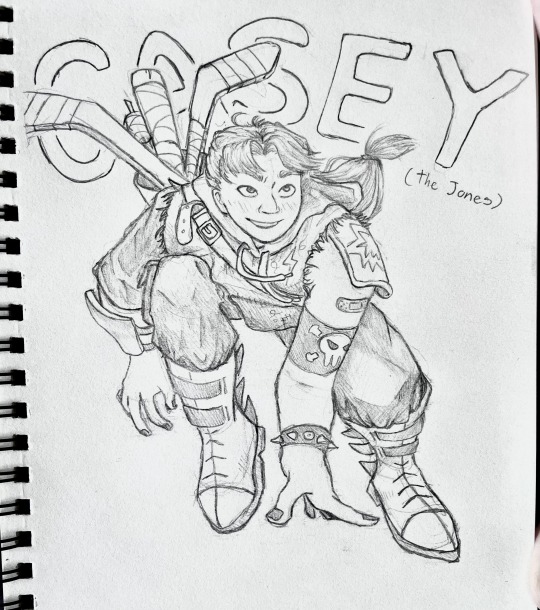
I literally have SO much to say about this Casey! this little rant is probably gonna go on for way too long lol (feel free not to read)
props to @camilieroart for writing this amazing au bc ive been obsessed ever since i saw it in passing on instagram.
Casey has always been my favorite tmnt character. Ever. Hands down. There was something about him that I just adored. As a kid and even now. That being said, finding a version of Casey that was so much like me was like an early Christmas. I was already sucked in to the AU since like, last year when I found it for the first time. But I only recently read through Casey’s backstory and found out that he was korean, which only made me double down on how much I loved his character in Colorcoded.
(I really hope this next part doesn’t come off as narcissistic, its really just me full of admiration for this character and AU)
It was incredible to see a version of my favorite character like EVER (not even joking) that looked a lot like me and came from a background a lot like mine. Beyond just his skin tone being dark and matching mine (which I think I commented about already) this Casey seriously feels like looking into a mirror of myself from a few years ago. Both visually and mentally. It’s refreshing to see Korean characters that aren’t reduced to the asian standards of beauty, but still look like their ethnicity, because we absolutely DO exist. From my darker skin color to even my wide nose shape which I share with this Casey, I was told constantly as a kid (by other koreans mind you) that I didn’t ‘look korean enough’. So it’s nice to see those features that made me so insecure growing up presented in someone I admired during that same period of time. Even Casey’s hair looks so much like the cut I had/was forced to get (lol) growing up, down to the M shaped bangs. Though I wasn’t allowed to grow out my hair like Casey has in the back, it was something I always wanted to do as a kid. I even got into ice skating BECAUSE of Casey, like, I adore him so so much.
Though I’m lucky enough to have a family much healthier than Casey’s, I still found myself relating a lot to him in terms of his Korean-American identity. Growing up, my parents wanted me to learn as much English as possible as opposed to Korean, but they switched mindsets when it came to my younger sister (Yeah! i’ve also got a younger sister too, and by just EXTREME coincidence, she also has a similar sounding name Hae-in 해인) so she speaks a lot more Korean than I do. I still struggle a little bit when speaking conversational Korean, even though it’s technically my ‘first’ language lol. My family even calls me by my english name and my sister by her Korean name. I’m not sharing my legal name online, but i’ve got the same deal as Casey where I’ve got an English legal name, but also an unofficial korean name which was REALLY surprising to read, because literally none of my korean friends have the same name situation. Beyond little nit-picky things (that don’t even count as mistakes, really) in his conversations with his sister, you got the Korean conversations down really well (like, the cadence and grammar and stuff, idk how to explain it, but it really sounds like a conversation i might’ve had with my little cousins, just translated)
TLDR: i absolutely ADORE this Casey and I see just SO much of myself in him. He is wonderfully written as a character and you nailed his korean-american identity to a T (according to me and my personal experiences at least)
SORRY FOR THE RANT
:)
#tmnt#casey jones#colorcoded#tmnt colorcoded#colorcoded au#tmnt casey#tmnt casey jones#teenage mutant ninja turtles#casey
46 notes
·
View notes
Text
Reprising this post: After my viewing of The Wrath of Khan, The Search for Spock and my read of the novel The Pandora Principle, it has come to my attention that Saavik's characterization can in fact be interpreted as a mirror to different aspects of each of the members of the triumvirate, while still maintaining that she is her own unique, profound character.
Now, the essay. I said I'd do it if one person asked and four kind people did, so here it is! Its under the keep reading, because it's quite long!
To begin with the most obvious, Saavik and Spock. He is her mentor, teacher and father-figure in The Pandora Principle (TPP) and she spends the most time with him.
Firstly, the backstory we gain for Saavik in The Pandora Principle more clearly establishes her as half-Vulcan, which parallels Spock’s own half-vulcan heritage. She lives through the same struggle to fit in with her Vulcan peers, while also facing her with the impossibility of finding belonging elsewhere, because her other half is half-Romulan. She’s an outsider among her own people, and in TPP, we witness her quite overcompensating on her Vulcan emotional control while on the Enterprise and faced with returning feelings linked to her past.
Secondly, this also connects to her difficulty reconciling her feelings (and she feels a lot and deeply, much like Spock) and her logic (which she does embrace, but sometimes struggles with). To me, it parallels Spock’s journey through Kolinahr, the failure of which puzzles Saavik, since she perceives him as a perfect Vulcan, she has a hard time understanding how he could have failed. It's toward the climax of the story that they truly connect emotionally, and she realizes that combining feelings and logic is ultimately the way Spock chose, and is no less Vulcan for it.
Thirdly, we see Saavik, from a young age, as someone who is extremely curious, who loves to learn and discover as much as possible. She quickly takes a liking to Spock’s tricorder, which he traded with her knife on Hellguard to get her to leave the planet in the opening scenes of TPP. After the year on Dantria IV spent learning the Vulcan way and starting her education, it is implied that she lived on Vulcan and continued her education there, before joining Starfleet.
That brings me to the fourth point. Much like Spock, she has a hard time fitting in, and ultimately finds her place not on Vulcan, but with Starfleet. She might not have tried entering the VSA, but considering her abilities and mind, she most likely could have attended if she had wanted to. Within Starfleet, much like her mentor, Saavik has a tendency to quote regulations, which I also wanted to underline here.
Fifth point, and perhaps a less obvious one, but both Saavik and Spock have a deep capacity for understanding people, their motives and thoughts. While they both explain it/it's implied that they understand it as “well, logically, that’s how this person’s mind set worked.” It's mainly that they are both very empathic people, telepathy or not. In many instance in TOS Spock explains the behavior of a character, providing insight to Jim/the others and the audience with excellent insight, while Saavik, once she learns of Jim’s method of the Kobayashi Maru, reads him like an open book about his lack of experience with true, final loss in the line of duty (Because Jim has lost people, just not the way he lost Spock in TWOK)
To continue on that, while she can also be really insightful, she also shows a struggle to fully comprehend humans and their illogic, such as her confusion at Kirk’s joke in the turbolift in TWOK or at her fellow student’s proclivity for “fun” in TPP. This clearly parallels Spock’s own difficulties, which he empathizes with in their video calls in The Pandora Principle. Much like him, Saavik also desires to understand more, which stems from her natural curiosity, and is manifested by her enrolling in the Academy's baseball team.
Also, much like Spock with Sarek, Saavik is afraid of embarrassing or disappointing her mentor/father-figure once she goes to the Enterprise in TPP. She truly wants him to be proud of her, which is similar to Spock’s own behavior concerning his father’s expectations (except he is way less restrictive than Sarek and is so proud of Saavik anyway)
To finish, Saavik is also quite sassy, with special mention to her interactions with Bones in TPP, very stubborn (once again, read TPP you won't regret it (I have a PDF if anyone wants it)) and self-sacrificial. These last few traits I think can be explained by “being raised by Mr. S’chn T’gai Spock”.
Following up, Saavik and James T. Kirk. While we mostly see them interact in TWOK and briefly in TSFS, Saavik grew up hearing stories about this man (TOS fan in universe, ain't this crazy) and does resemble him more than I think even she knows.
To begin, both of them lived through absolutely traumatizing events in their childhood/youth, which deeply impacted their character. Saavik grew up on Hellguard, a Romulan colony in which she and the other children were abused, tortured and starved, in spite of the presence of replicators, then were abandoned on the desertic surface to fend for themselves, resulting in infighting, starvation, murders and deaths. This highly traumatic event, caused by authority figures and involving starvation is familiar to TOS fans, reflecting quite easily what Jim went through during his teenage years on Tarsus IV. Resulting from these events are many of Saavik’s and Jim’s survivalism techniques, trauma surrounding food (Ever noticed how Saavik is staring at Jim on Genesis planet when he mentions that food is first order of survival? I did.) as well as trauma, some mistrust and anger toward authoritarian figures and survivor’s guilt (or even just guilt regarding her actions in Saavik’s case, who implicitly had to kill and resort to violence to survive.)
After this massive paragraph, we can continue on happier comparisons. Saavik, just like Jim, is an exemplary Academy student. While she isn't called a “stack of books with legs”, it is implied that she is quite involved in her studies, while also taking some time to bonify her understanding of humanity on the side. Her insistence at understanding the test and what it was truly evaluating shows her devotion to her studies and even a perfectionism that Jim “youngest starfleet captain ever” must also have displayed at her age.
To continue, while much like Spock she chose Starfleet over the VSA, she doesn’t follow him in the science tract, but rather in the command tract, much like Jim. While in the Kobayashi Maru simulation, she shows a natural proclivity to it. She has a good command instinct, knows how to make decisions even in the face of highly stressful situations (even in simulation, we can see Spock's simulated-death shocked her), and yet she continues on, sends out orders, whips out strategy and asks for damage reports. Until the end, she keeps control and calm, even in the face of impossibility to win.
On that point, her questioning of the test, while it also could be read as her finding illogic that the test is unwinnable, also seem to me as a parallel to Jim, of not believing in No Win Scenarios. Even her presence on Genesis in TSFS, following her assignment to the USS Grissom, seems to me that in her grief, she still held some form of hope and desired to find a way. (And beside, she and Spock had promised that if one went lost, the other would find them in TPP)
To continue on, Saavik and Jim both have a sharp sense of right and wrong and justice, once more a consequence of their upbringing, but also a quality that serves them as commanding officers (and future commanding officers in Saavik’s case)
Also, both of them are exceptionally kind, and feel deeply, even if in Saavik’s case it’s not always as clear, her inner monologue in TPP truly shows that her emotions are strong. We see her anxious, happy, excited, afraid, apprehensive, angry, resentful, and many other emotions. She is also haunted by the events of her past and the emotions linked to it, in a way that mirror’s Jim in the episodes Obsession and The Conscience of the King.
To conclude, she too hate going to sickbay, as illustrated by her reluctance to be examined by McCoy even after her injuries upon the return to Hellguard in TPP, is also very stubborn (Thats a trend with the triumvirate) and I think I can liken her self-sacrificial tendency to Jim’s too.
(Little bonus similarity to AOS Jim, has what can be seen as a crush on Uhura the first time she sees her, she says: “But I have never seen anyone so aesthetically pleasing. I was unaware of that quality in humans. Oh.”)
Last but not least, Saavik and Dr. Leonard “Bones” McCoy. You might not expect it, but they do share similarity.
Firstly, I want to once again mention her emotions, and that Saavik, while Vulcan and mostly shown as aloof, can also have quite a temper, even more on Hellguard as a child and soon after leaving the planet. When she doesn't succeed at using a tricorder at first, she begins to yell at it, insults it and flings it around. That blatant show of anger and/or impulsivity can be likened to the grumpy doctor, who while he is an adult and much less exuberant in it, doesn't shy away from his anger. The way Saavik feels, and how we can truly see her mind in the narration of TPP truly likens her to the emotional McCoy, while she also attempts to balance it out by emulating Spock’s logic, and falls somewhere in between, much like Jim himself does in many episodes of TOS. (Oh wow, the premise of this essay is that she is like the three of them!)
Secondly, Saavik swears! If this isn’t parallel to McCoy I don’t know what is. In TWOK, we hear her say “Damn” on the bridge, but it doesn't end there. On Hellguard and afterwards, she quite often uses Sonabastard! as an expletive and as an insult. She also, once she has been told the story of Amok Time, calls T’Pring a bitch, quote here:
"She was a bitch!"
"That is, among other things, inaccurate. The term refers-"
"Oh, I know what it refers-and that's what she was! What she did was bad!" Saavik stopped in the lane and stamped her foot, temper brewing. "You say it is bad to hurt people, but she made people hurt each other! That is much badder! She was a bitch!" Spock didn't trust himself to comment; he came perilously close to agreeing with her.
That whole sequence illustrates a sense of justice she shares with both Jim and Bones, as well as an impulsive mouth and anger. But most importantly, it illustrates her kindness and empathy, a trait she also shares with McCoy, albeit once again often shrouded in grumpy care for the doctor and in righteous anger in Saavik.
To continue, she can also seem sassy, a trait I have also mentioned in relation to Spock, but can apply to Bones as well.
And to no one's surprise, I will once again mention stubbornness and self-sacrifice.
Well, this concludes my analysis, thank you for reading, don’t hesitate to add on or correct me in any case.
#saavik#s'chn t'gai saavik#Star Trek#Star Trek tos#star trek movies#Star Trek novels#the pandora principle#Spock#s'chn t'gai spock#james t kirk#leonard mccoy#bones mccoy#character analysis#essay
32 notes
·
View notes
Note
info dump about raggedy ann and andy, just recently watched the show and i am in love B))
hello!! ive been in the fandom for two and a half years (almost three lol), so i know a bit about raggedy ann and andy.
so raggedy ann and andy were created in the early 20th century, the former sibling coming first with her patent in september 1915. the most popular legend surrounding her creation is that she was based off an old rag doll that belonged to creator johnny gruelle's mother/sister (can't remember exactly), who he then drew a face on and gave to his beloved daughter, marcella, who sadly would pass away months after ann's patent. marcella's inclusion in the raggedy books has been seen by many raggedy historians as johnny working through his grief by immortalizing his daughter's likeness in his stories to remember her in a positive way. andy came around in august 1920 and is said to have been created with johnny's sons, worth and richard, in mind.
the 1977 film is probably where a lot of the younger fans first became interested in raggedy ann (well, that and tadc, and even then gooseworx is a pretty big fan of the film and even specifically based jax's voice on raggedy andy from the film), although the 1986 broadway musical has also been bringing a lot of people in through tumblr and tiktok. the film, despite ultimately flopping at the box office, had the esteemed richard williams at the helm of the animation, even animating the ever so popular "no girl's toy" sequence. of course, richard williams being richard williams, went way overbudget and way past the deadline and ended up being removed from the project just so it could get released. considering the composer of the film, joe raposo, theorized that the film flopping had something to do with the first star wars movie being released around the same time, it's interesting to think about how the raggedy film's fate could've been altered if it had released the year prior for america's bicentennial. the 1986 musical is a whole other can of worms, and im still learning a lot about it from being in the RARE server (which you should definitely check out, wink wink nudge nudge), but to summarize, a combination of a development team constantly at the brink of self-destruction, constant adherence to a family-friendly atmosphere spurred by parental concerns despite the dark themes playwright william gibson intended the story to have, and too much of the budget spent on expensive special effects that nearly killed the actors led to the musical notoriously flopping on broadway and ending its run prematurely never to be seen or heard from again. or so they thought.......
although the 1986 musical is considered a failure in the united states, over in russia, the story has a small cult following amongst childrens and community theatre productions. basically, in 1985, the musical was brought to the USSR as part of a cultural exchange between the two superpowers, and considering that russians had not been familiarized with raggedy ann or her cultural impact up until this point, this led to the rag doll and her friends not being seen as cheap americana, but rather somewhat of a childrens fable (ironic, considering raggedy ann as a character was born from johnny gruelle's stories...). because of this, russian productions of rag dolly (the 1986 musical) are plentiful, with even some very recent productions popping up every now and then. it should be noted that these productions rarely contain the original songs; sometimes the story will just be played straight with no music, while other productions will substitute the lack of musical songs with their own music. this can lead to some..... interesting results lol
i feel it is also important to bring up the various other adaptations of raggedy ann, too! there's the original books, of course, but if you're an animation nerd like me, there's the 1941 fleischer short (which takes some.... interesting creative liberties from the original source material), the two noveltoons shorts, the chuck jones holiday specials from 1978 and 79, the 1980s cartoon (watch at your own risk lol), and the two snowden specials from 1998; one is just a straightforward direct-to-vhs animated special, while the second is a full ice show with animated segments dispersed throughout. you get to see raggedy elvis! who doesnt want to see raggedy elvis?
in this last section ill just toss to you a bunch of links i recommend if you wanna learn more about raggedy ann beyond the movie!
(i should also probably mention now that some books and adaptations of raggedy ann feature racial stereotypes- i know suddenly its spring has a racial caricature in terms of adaptations specifically- likely due to the culture at the time. these depictions are obviously not right, but sadly when we're talking about a franchise that has been around for over a century, it's kind of unavoidable especially in the older books, so just be aware that those depictions will come up occasionally.)
youtube
youtube
youtube
youtube
youtube
youtube
youtube
youtube
youtube
youtube
my pal brooklyn is also working on a more extensive video on raggedy ann history, so be on the lookout for that when it comes out :)
#raggedy ann#raggedy andy#raggedy ann and andy#raggedy ann and andy a musical adventure#rag dolly#rag dolly musical#charlie’s last remaining brain cells fighting for survival
97 notes
·
View notes
Text
2024 retrospective and 2025 goals
this is the censored version of this post. for full images, check out the full free post on subscribestar!
hi :)

i'm really happy with everything i achieved in 2024. it was my first year illustrating full time, meaning no school and no salaried job on the side (believe me i tried to get one) and i'm happy to report i did not die! fuck yes. i even illustrated for 7 (i think) art books, designed merch for 2 and organised my first collab fanbook.
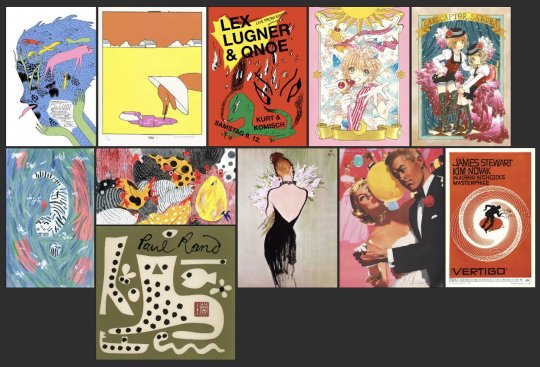
from top left clockwise: michael deforge, anna haifisch, Michel Esselbrügge, CLAMP, saul bass, jon whitcomb, rene gruau, paul rand, molly fairhurst
at the beginning of 2024 i made this moodboard for influences i wanted to incorporate into my work more, they are pretty much the same faves ive had for years but i just wanted to have them in front of me and start deliberately choosing elements to ape.
i'd say i basically want to incorporate more 2D cartoon graphic elements combined with detailed, realistic, delicately rendered characters, more theatric background design and props... features like borders etc. the thing about a moodboard is unless you print it out and put it up by your desk it will sort of slide to the back of your mind which is what i think happened w mine LOL. cuz looking at this now im like well i didnt really hit all these ideas but i did inch closer.

the first pic here is sth i drew immediately after making the board and i like it but it does feel like a slightly clumsy attempt at mashing stuff together... i wouldn't say that it shows i dont understand whats appealing about the work i was referencing (even though thats how it looks), its more like the picture goes in an unexpected direction while making it LOL. but that's part of the fun. whereas in my mind the 2nd pic spiritually embodies the ideas of the ppl i'm trying to copy. even tho visually it's still a ways off. its probably my favourite thing i drew all year? :) though that's hard to say bcus i'm so pleased w so many other pieces especially those u can see on my summary pic!!!
i have a few more artists i wanna add to my board and then i will definitely print it this time so i can look at it every day instead of just twice a year LOL.

another thing im really pleased about is the number of comics i drew in 2024. i have this odd relationship with comics where i do draw them and have for years and im more or less decent at them but i act like drawing them mortally wounds me. like im so dramatic... i do partially believe the only way ill ever be able to complete a longform comic is through abusing stimulants but you know ill also never find out if i keep crawling off to die after inking a page. i see a lot of illustrators suffering when approaching comics from the illustration mindset of making beautiful pictures instead of the comics mindset of making finished pictures, but u know, im extremely slapdash as an illustrator and im also proud enough to believe im a guy that can do both, so its really time i act like it... basically just shut up and draw. i want to apply this especially to perspective drawing/panel backgrounds, which im, like, fine at. honestly fine at. i do think i trip myself up because i want to be the next dostoevsky or beyonce or whatever, i want to be great, but have to remember the most anyone can do is aspire to express something from your inner world. everything else is secondary.

one thing i learned the hard way is how hard it is to have work life balance when you work from your bedroom and 'monestise your hobby'... you know, the thing everyone has been warning each other about for years. turns out its real. its super confusing when so many elements of your work bleed into your social life, physical health, leisure time etc -- like i go online for fun, and also to promote myself. so wheres the distinction? i watch movies for entertainment but also for research... ive definitely felt like ive been working around the clock or my job has consumed my life at points. but i think being stricter with my work hours is the way forward. it truly is shaytan at the wheel when u answer an email at 3AM... no more of this!
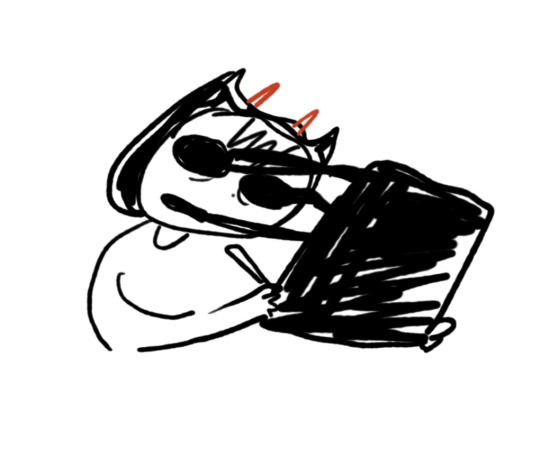
and tied into this is being realistic about what i can achieve in a day and not feeling ashamed or that i need to do more... i get stuck in this silly loop that's like... 'i believe everyone should work 4 hours a day, but because other people are stuck working 40 hours a week i should also be making myself do that' and then i work myself into a flare up and wreck my work ethic and enjoyment. u can laugh... i know it doesnt make sense. well i wont do it any more. because i CANT... because i will DIE... some days i work 4 hours. some days i work 6. some days i work half an hour... it doesnt matter as long as stuff gets done.. and it does.
also want to talk about my chronic pain and hypermobility... after a year of lifting weights i am stunned to let u know ive actually improved. unfortunately i dont look anything like the rock and i still cant do a real push up but im stronger and have more stamina and suffer from way less zaps and aches and numbness, which was unthinkable before. i only really noticed after taking a trip and doing different activities (painting walls) that i can physically do a lot more than i usually do at home. but also my house is fucking cold so its hard to do anything for anyone. hoping for warmer days and big muscles to come.
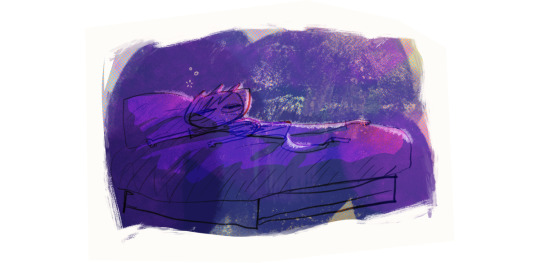
some of my other art goals are to work more on paper whenever i can. i used to have a huge stack of newsprint on my drawing board underneath my ipad and id doodle and test ideas on that paper before drawing it digitally. i wanna do that again. many people find its easier to 'think' on paper and im the same. whenever i have an idea i wanna go 'what would this look like on paper?' and then find out.
i want to be thinking about composition and storytelling more in my illustrations, as in, think cinematic, movie posters, communicating big ideas. even if that idea is only as big as 'this blue looks great with this orange'... i want to make more stuff that looks like promotional material for my stories. of course behind every movie poster is 100,000 thumbnails and sketches and half-finished ideas. i want to remember that and not be hard on myself for drawing girl in profile #997.
i want to draw more autobio comics, just to be drawing more comics and also to look back on and know what i was doing that day. nothing fancy. a lot of people are doing that gentle comics habit this year and i fear my competitive nature may get me into it too.
i have more books i wanna create which ive talked about at length in my last diary entry and for now i think that's enough goals thank you very much. thank you for reading this far and for all your support. happy new year! love you x

13 notes
·
View notes
Text

Someday I'll Write It:
Lady Vader Part IV
It took quite some time to set up the meeting.
First, there was the matter of identifying the correct individual to approach.
What Padmé proposed to do was equivalent to showing a Sabacc hand to her neighboring player and hoping that the combined knowledge of two hands was enough to defeat the opponent across the table. Choose the wrong person and the Rebellion's game was blown. Completely.
Then came coordinating the logistics to ensure everyone's safety. At least, as much as safety could be assured when working under the very nose of the tyrant one hoped to overthrow. Padmé had been adamant that the Rebellion's target would not suffer becoming one for the Empire. Anakin had been adamant that he felt the exact same... about her. He could bear the brunt of the unsavory tasks asked of him, he insists but he couldn't handle her standing unnecessarily in the crosshairs.
When she had pointed out that what she was doing was out of necessity, he paced their apartment floor, gnashing his teeth about her foolhardy stubbornness and the insanity of this plan. She had cut her teeth with legions of detractors when she was only a nascent teen. Her husband's ire was mere childsplay, even if he'd stalked about like the dark and stormy Sith Lord he was supposed to be.
As they reach their rendezvous, Anakin is again on edge. She gets the feeling from the hard thrust of his stride and the loud huffs he makes - likely holding back his protests - that now would not be the time to mention the old story about tension and gundarks.
Stopping outside the office door, his cobalt eyes plead with her before his lips can. "Padmé, I have a bad feeling..."
"Shhhh, Ani," she soothes, her hands unfolding from under her cloak to smooth his leather tabards. "I'll do all the talking, you just stand there and be intimidating."
He mumbles something in Nabooian under his breath, and the cheeky expression - no doubt learned from one of his nieces - calms the butterflies flitting about in her own stomach.
She nods once, and he palms the access panel to Galen Erso's office.
Almost immediately, the owner of the cramped workspace rises to his feet, the color draining from his face at the sight of the galaxy's most notorious couple standing before him.
"My Lord! My Lady!" He remembers to bow. "To what do I owe the honor?"
Lady Vader lets Padmé Skywalker smile at him. A real genuine greeting. He smiles back, nervously watching the other man in the room as he does.
She wastes no time in outlining the Rebellion's scheme. The one that relies on the head engineer making the indestructible Death Star beatable. The one that could burn it all to stardust or vanquish an Empire before it can take further poisonous root.
"What you're proposing is treason! Why are you involving me with this?"
Galen doesn't seem likely to fold, and Padmé isn't surprised. She's showing him a lot of their cards but she still keeps one close to her chest.
As the leaders of the Rebellion had grown more impatient with each passing day, little did they know that the delay actually gifted them a game-changing advantage.
Anakin fidgets behind her as she shrugs the heavy velvet cloak from her shoulders.
Galen's eyes widen at the gentle swell of her stomach.
"Because like you and Lyra, Anakin and I want our child to grow up in a free galaxy."
Image credit: Eli Hyder
#anakin skywalker#padme amidala#anidala#someday i'll write it#star wars#lady vader#au fanfiction#this is getting out of hand
26 notes
·
View notes
Text
Ranking The Stranger Things Tie-Ins:
Now that I've finished the reviews (for the time being), I wanted to do a ranking of all the tie-in comics, graphic novels, and books. Originally, I was just going to do a Top 5 Best and Worst List, but I figured it would be more fun to make a complete list of all the tie-ins while also giving my brief thoughts on each one (especially for those who don't want to read my lengthy reviews). Please note this is all in good fun and just my personal opinion, which can be subjected to change.
Also, this list will NOT include any of the show's episodes, video games, tabletop games, children's tie-in books, the Choose Your Own Adventure book, the Stranger Things Experience, or the stage play The First Shadow.
With that out of the way, let's begin in order from Worst to Best:
#26: Stranger Things Summer Special (See Review Here)
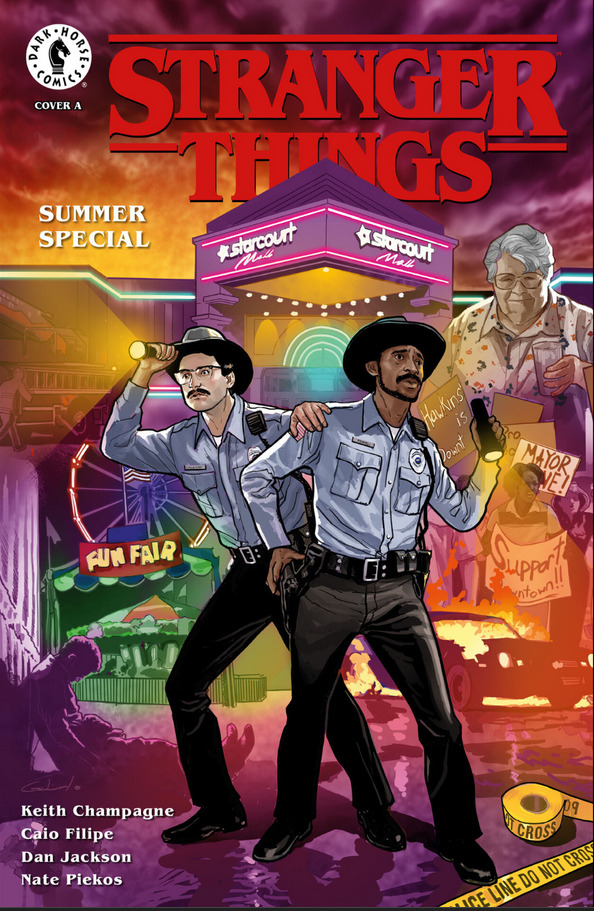
I never cared for Powell and Callahan as characters. They barely have anything to do with the show's main arc, they're NOT funny, and the "bumbling cop" trope is something I've grown tired of in recent years.
The premise of this short, where both of them are conveniently present at key events during season 3 in their lousy pursuit of being "good cops," all the while having constant near-misses with the Upside Down, the Flayed, and the Meat Flayer, is a repetitive joke that quickly grows old. That's not even getting into the huge continuity errors plaguing the short and creating a bunch of plot-holes. Completely unnecessary. Hard pass.
#25: Stranger Things The Bully (See Review Here)
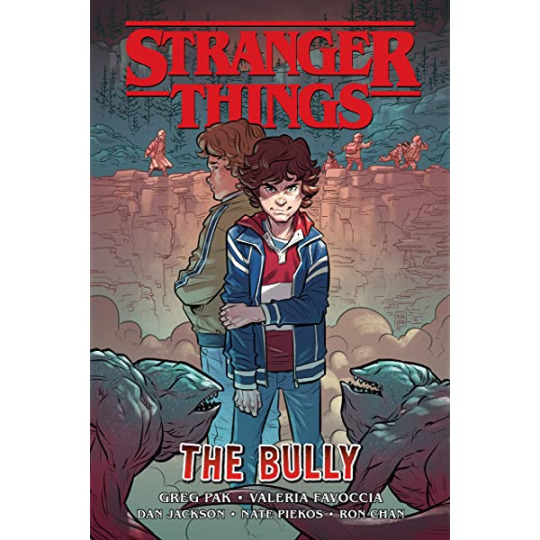
This only ranks slightly higher than Summer Special because I like the artwork better, and it doesn't mess up the show's continuity like the previous comic did. However, that's all this really has going for it.
For whatever reason, they decided to make an entire graphic novel focusing on Troy and James (the bullies from season 1), and all I could think about while reading it is "This is a huge waste of time." I already didn't like Troy to begin with, this comic does NOTHING to improve my opinion of him, and considering that neither James nor Troy have appeared on the show since (and probably aren't coming back for season 5), I don't see what the point of this story was. This paragraph from my review sums it up best:
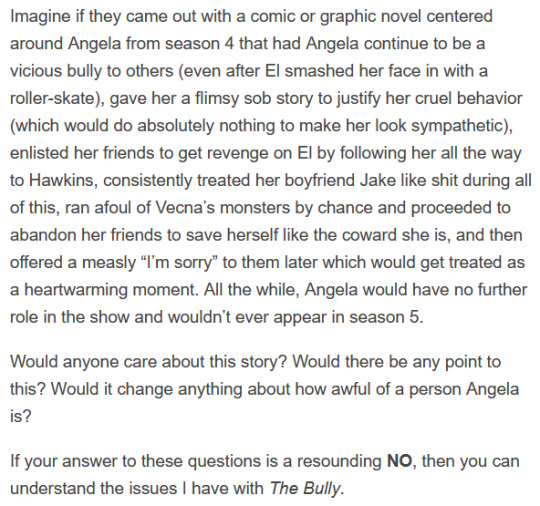
#24: Stranger Things x TMNT Crossover (See Review Here)

I'm sure there are fans who enjoyed this bizarre trip while embracing its absurdness and surrealism, but I am not one of them. I like TMNT and I like Stranger Things, but I draw the line at saying both properties exist in the same universe. That's not even getting into the haphazard attempts by the writers to make this comic canon with the show. Knowing the Duffer Brothers, that's likely not going to happen.
#23: Stranger Things Tales From Hawkins (See Review Here)
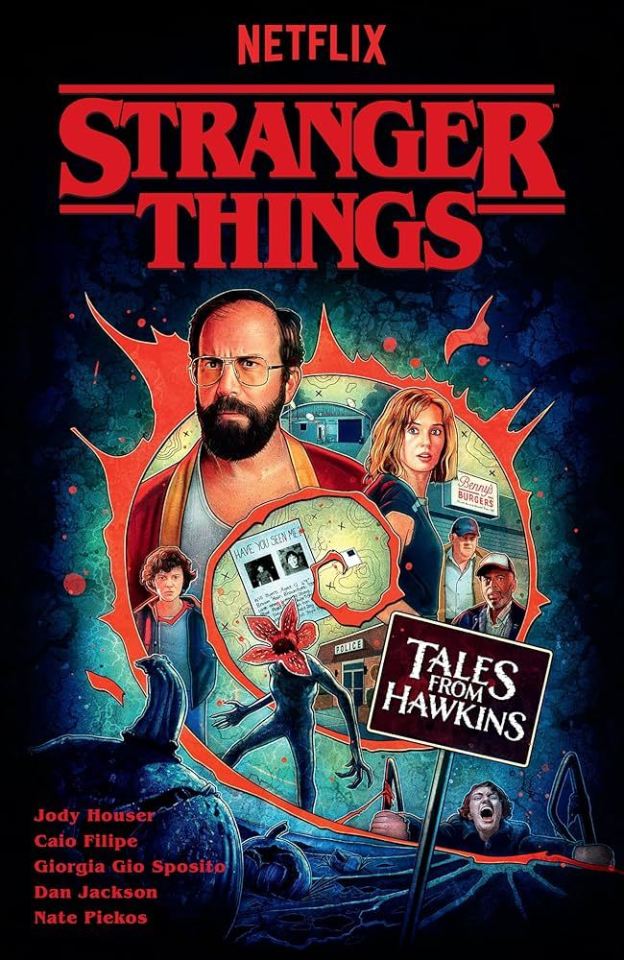
The idea of doing an anthology comic focusing on Hawkins residents was intriguing, but the end result was disappointing. They should have broadened their horizons regarding which characters to focus on, and not just set the stories exclusively in the first 2 seasons.
Murray's story (Issue #2) and the Pumpkin Patch Rivalry (Issue #4) are arguably the best ones. The rest are either forgettable or derivative.
#22: Stranger Things Six (See Review Here)
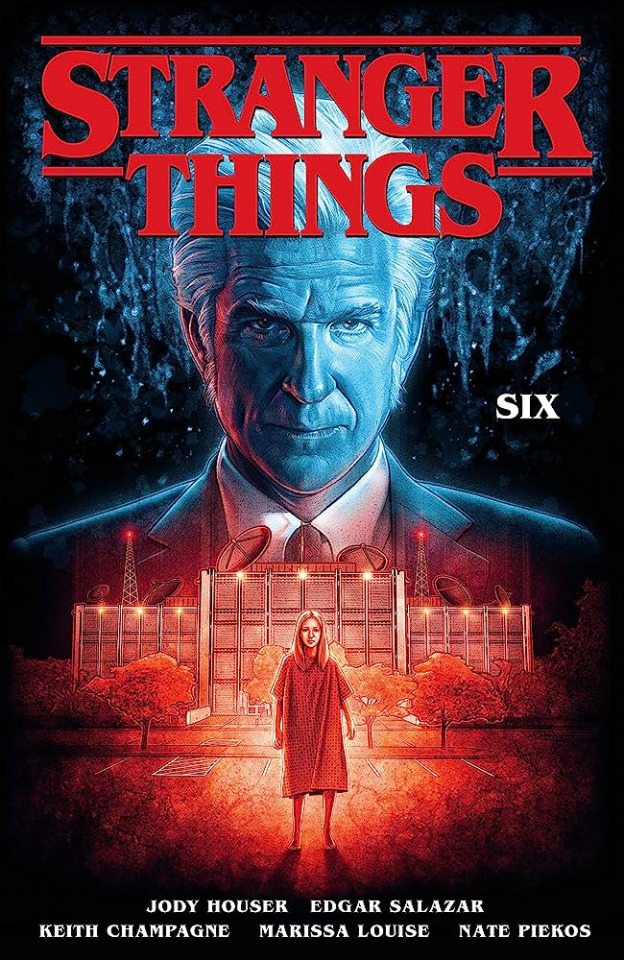
My first venture into Stranger Things comics. I've come a long way since then! :)
I remember looking forward to this particular comic to learn more about Hawkins Lab, Dr. Brenner, Project MKUltra, and the special kids............only to feel underwhelmed when I actually read it. I wanted to like Francine/Six, but I didn't find her interesting or compelling as a character, and the attempts to include other aspects of the show's lore (i.e. The Upside Down, Terry Ives, El and Kali, etc) felt shoehorned. Combined with the direction season 4 went, and it's a safe bet to say this comic is NOT canon (if it ever was).
#21: Stranger Things Suspicious Minds (See Review Here)
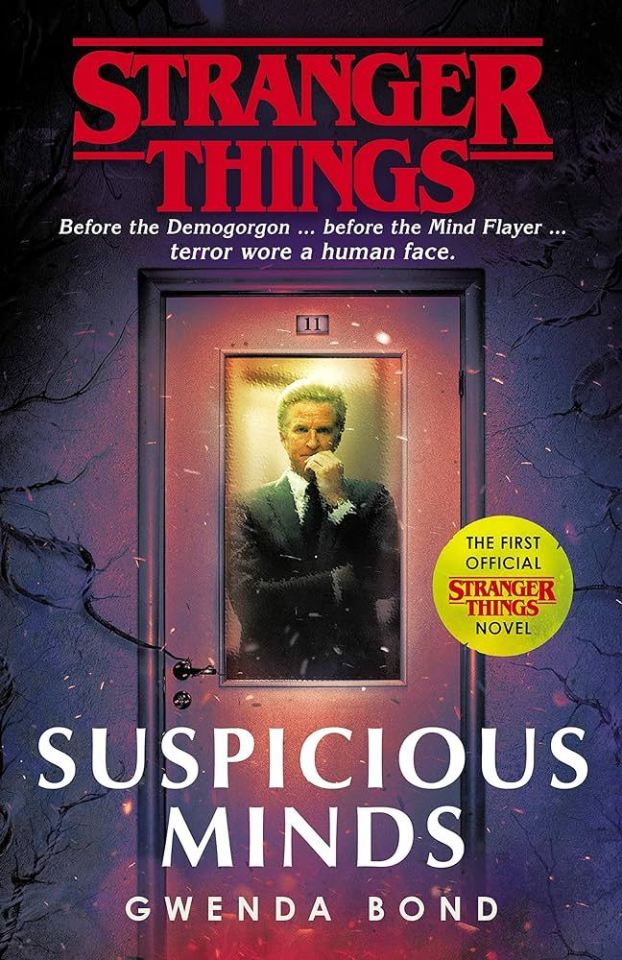
Suspicious Minds ranks slightly higher that Six for doing a better job fleshing out the experiments that were taking place at Hawkins Lab, as well as giving more details about Kali, Terry Ives, the test subjects, and El's biological father Andrew. It helps that Brenner is a threatening presence in this book, and that the narrative excels in maintaining suspense.
However, similar to Six, the events of season 4 render most of this book non-canon. That's not even getting into a major continuity error regarding El's date of birth that sticks out like a sore thumb.
Suspicious Minds serves as a cautionary reminder that if you're a creator and you've planned out a major twist for your show, then you either need to have a direct hands-on approach to how tie-ins are written and approved, or you need to be willing to share that twist with those you've hired to write tie-ins for the universe you're managing.
In any case, it is PAINFULLY CLEAR the Duffer Brothers didn't share information about Henry/One/Vecna with Gwenda Bond when she worte this book (or Paul Dichter for that matter when he helped oversee its development), and boy does it show in the final product. 😖
#20: Stranger Things Kamchatka (See Review Here)
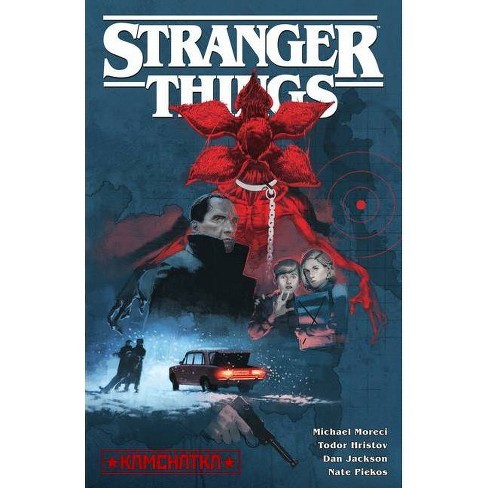
Another example of a comic where the premise sounds intriguing, but they squander it on characters who aren't going to play a role on the show while also giving very little (and in some cases, contradictory) information about the show's lore.
While I liked the darker tone, the Cold War setting, and the spy thriller aspects, the characters didn't do much to impress me, and I was also frustrated by the lack of canon characters (Hopper, Dmitiri, Yuri, etc) who could have been in this comic and weren't. It's not bad, but it is mediocre when it didn't need to be.
#19: Stranger Things Into The Fire (See Review Here)
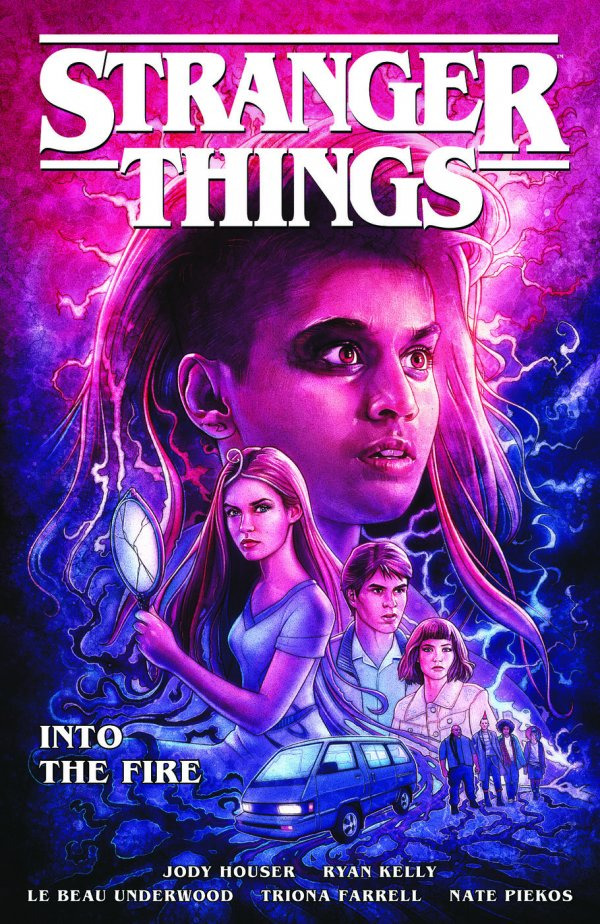
A sequel that improves on its predecessor (Stranger Things Six). While the comic likely isn't canon for the same reasons Six isn't, I appreciated the personal stakes this time around, I loved the creepy gothic aesthetic they did with Jamie/Nine's hallucinations, and it was nice to see Kali utilized in this story in a meaningful way. Here's hoping the Duffer Brothers wise up and bring Kali back for season 5 because she deserves so much better!
#18: Stranger Things Creature Feature (See Review Here)
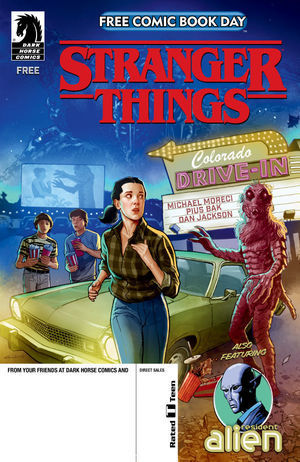
One aspect of Season 4 that was disappointing was how little we got to see of the family dynamic with El and the Byers once they moved. It's hinted at, but not explored deeply. Creature Feature dives a little more into that, as well as El's struggles with PTSD, and gives a nice heartwarming scene between El, Jonathan, and Will towards the end that makes the short stand out.
However, the one-shot comic is sadly brief, and it may leave people frustrated about why they didn't go for a longer comic/graphic novel about El and the Byers adjusting to life in Lenora. I would've been interested in seeing that!
#17: Stranger Things The Game Master (See Review Here)

A one-shot comic where we get to see Steve and Nancy back together after the events of season 1 while also getting a surprisingly sweet interaction between Steve and Mike that isn't them griping with one another. I don't care much for Steve and Nancy's relationship, but I did like their attempts to help Mike feel better after El's apparent death. That was enough to elevate this short.
#16: Stranger Things Erica's Quest (See Review Here)
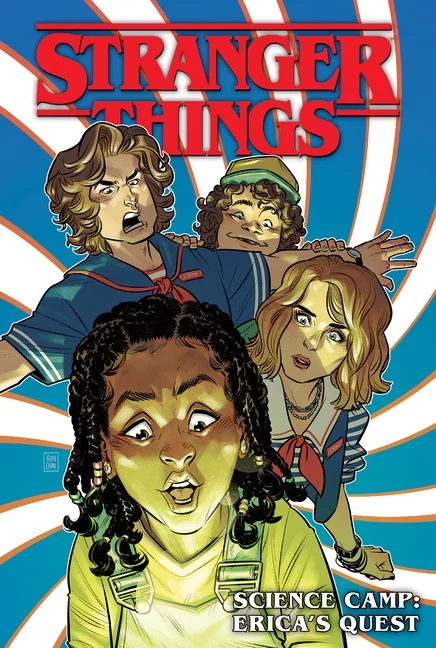
Not a fan of the artwork, but I was happy to witness the Scoop's Troop back together again. I also love how this short confirms Steve has played D&D before, which gives context to that scene in S4 when Dustin calls Steve asking him to be a substitute player in Eddie's D&D campaign.
#15: Stranger Things The Voyage (See Review Here)

Major improvement on Stranger Things Kamchatka. It's highly doubtful the show will include any mention of this comic (though if the Duffer Brothers decide to bring back the Russian arc for S5, I hope they incorporate Dr. Karine as the main antagonist), but the story is scary, suspenseful, and has the kind of gruesomeness you'd expect from an R-Rated horror film.
#14: Stranger Things Darkness On The Edge Of Town (See Reviews Here)

Having grown up reading a lot of murder mysteries, I have a soft spot for the genre. Hearing that Hopper's backstory involved him tracking down a deranged serial killer in New York City back in the 70s while also dealing with a dangerous cult was enough to get me on board with this book.
This novel isn't perfect, but it makes up for its shortcomings in creative ways. Hopper's backstory with the NYPD is fascinating, the story's focus on issues related to poverty, crime, mental health, law enforcement, and societal woes works well (even if they drop the ball towards the end), Hopper's interactions with El in the present are a highlight, and the narrative is effective in keeping the reader invested.
#13: Stranger Things Erica The Great (See Review Here)
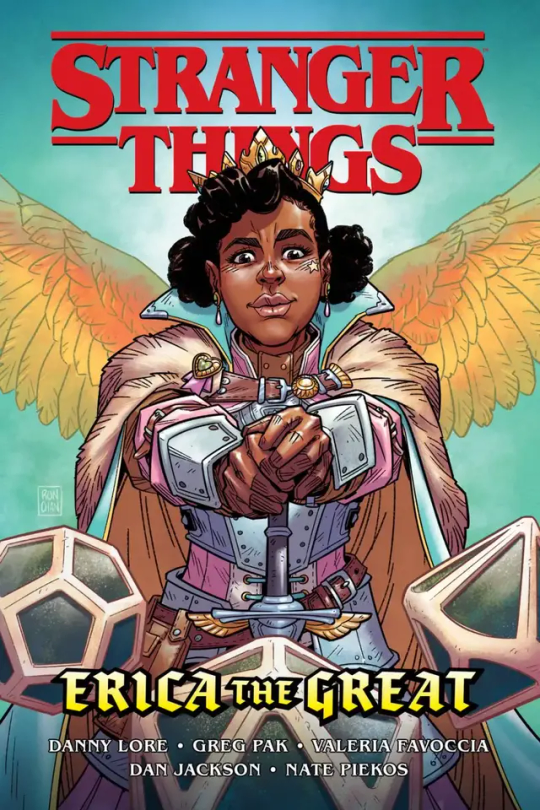
A light-hearted graphic novel that bridges Erica's arc between seasons 3 and 4 while expanding on her growth as a character and development as a D&D play. It was cool seeing Erica's friends get their day in the limelight (one of whom might be making an appearance in S5), and the story has enough funny moments to keep the reader entertained.
#12: Stranger Things Flight Of Icarus (See Review Here)
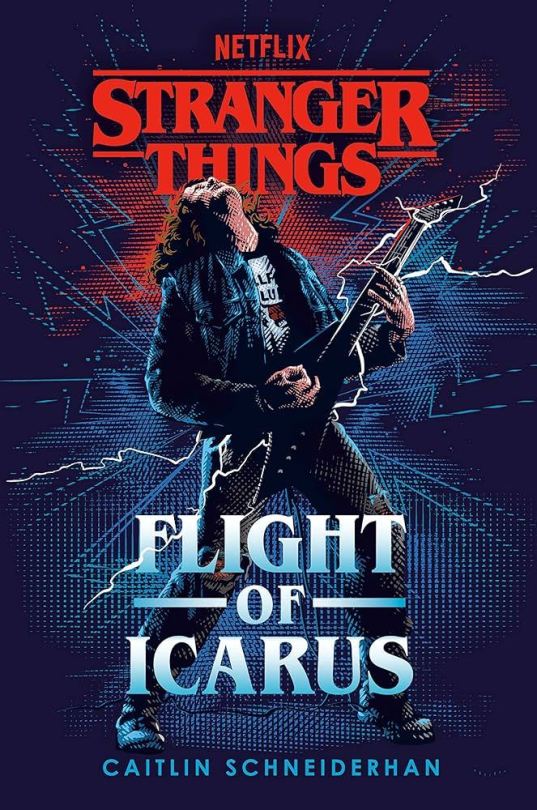
I know fan reaction towards this book was cold when it was first announced, and I'll admit parts of it were hard to read given we all know how Eddie's story ends. I'm not a fan of media that teases false hope to the audience, only to cruelly yank it away.
That being said, I will go to bat for this book: It's well-written, and does a good job expanding on Eddie's character and his relationships with others (Wayne, Al Munson, Jason, etc). I also appreciate the book's themes regarding "forced conformity," and its scathing criticisms towards individuals and institutions (school teachers, law enforcement, students, residents, etc) who scapegoat and punish people like Eddie for existing while allowing (or in some cases, enabling) truly vile people to get away with being vicious and cruel towards "acceptable targets."
Considering how certain individuals on Tumblr and varying social media platforms have been treating others for the past few months, this book couldn't have come during a more relevant time.
#11: Stranger Things Halloween Special (See Review Here)
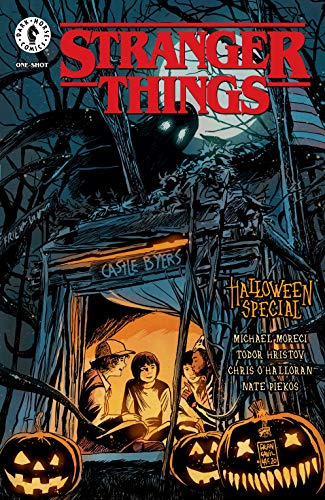
A delightful Halloween comic taking place before season 1 which centers around the Party telling an urban legend about the Child Eater of Hawkins, which coincidentally has eerie parallels to Vecna. Creepy artwork, an unsettling atmosphere, and a fun twist at the end! :)
#10: Stranger Things Hawkins Horrors (See Review Here)
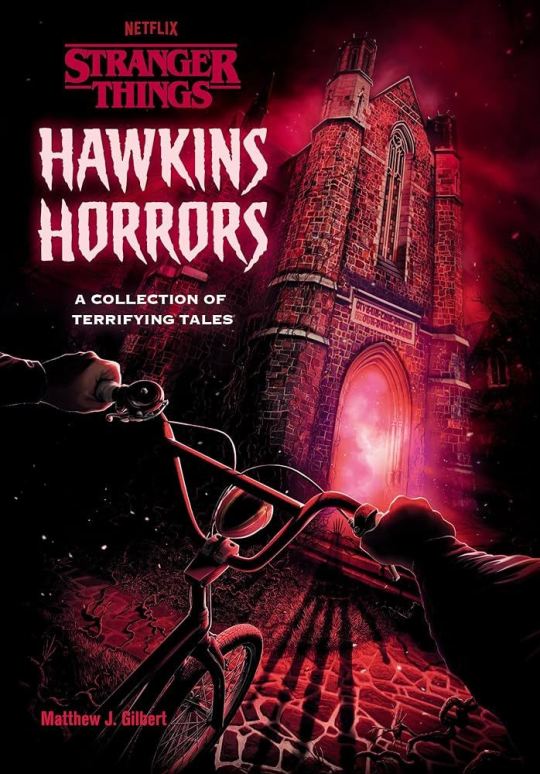
Same deal as the Halloween Special, except it takes place between Seasons 3 and 4, and features multiple horror stories told by Steve, Robin, Nancy, Max, Lucas, Erica, Dustin, and Mike while they're all trapped in the Video Store during a power outage. The stories are scary and reminiscent of horror anthologies like Tales from the Crypt and Goosebumps, and some of them even cheekily foreshadow certain events that occur in season 4.
#9: Stranger Things Runaway Max (See Reviews Here)

Like Flight of Icarus, this book is hard to read, albeit for a different reason: I don't enjoy stories with characters trapped in abusive situations, and this book does not pull its punches in depicting the utter hell Max suffered through living with both Neil and Billy.
That being said, I grew to have a new appreciation for Max's character because of this book, and I liked seeing her backstory, her perspective on the events of season 2, and her thoughts about the characters she interacts with. I loved seeing her relationship with Lucas develop, I liked her brief interactions with Steve, and there was a satisfying payoff in her standing up to Billy and finally regaining some control over her life. If you love Max's character, this book is for you!
#8: Stranger Things Winter Special (See Review Here)

The closest Stranger Things will ever have for a Christmas Special (not counting the endings of the first two season finales). So many little details (i.e. the way the Party explains different Christmas stories to El and how she visualizes them, the revelation about what happened to the demodog in Joyce's fridge, etc) that make this an enjoyable read.
#7: Stranger Things Lucas On The Line (See Review Here)
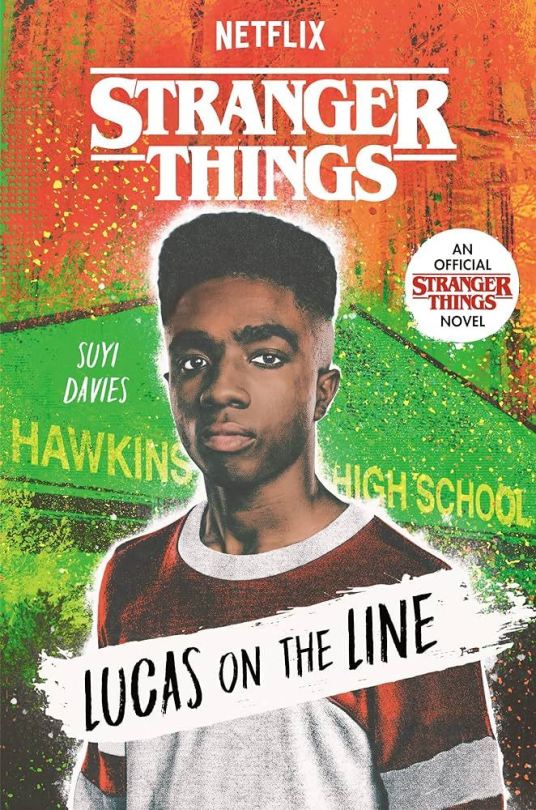
One thing I will say for the tie-ins is that I appreciate how they expand the perspectives of characters from the show. Such is the case with Lucas on the Line. It takes place between seasons 3 and 4, and explores Lucas's attempts to come to terms with his trauma, the growing rift between himself and Max, his attempts to balance his strained relationships with his friends and his desire to play basketball and break out of the "nerd" stereotype, and it gives a very brutal but effective portrait of what it's like for Lucas to be one of the few black kids in Hawkins constantly surrounded by people who are either outwardly racist or project their biases and prejudices in truly insidious ways.
There are two reasons I'm not ranking this novel as highly even though it's a fan-favorite: 1.) There are continuity errors that took me out of certain moments while reading it, and 2.) The third act (which is when S4 begins) does a clumsy job tying in with the rest of the book and its themes. I really wish the book had continued with Lucas's story up to the end of S4 instead of stopping halfway through.
#6: Stranger Things The Other Side (See Review Here)
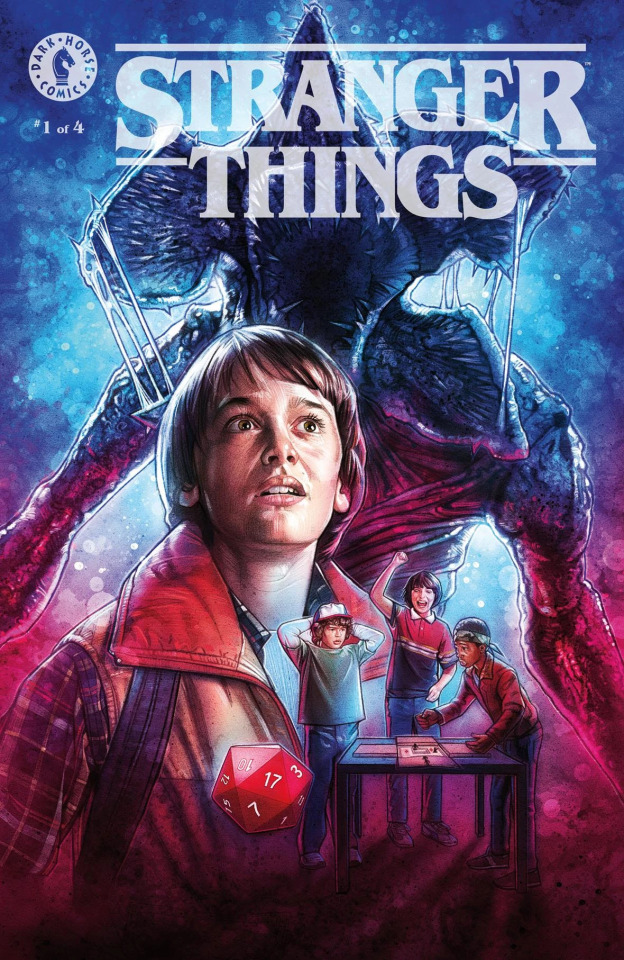
I always wanted to know what was going on with Will in season 1 when he was taken to the Upside Down. This comic thankfully elaborates on that and doesn't disappoint. Will's journey to survive is both intense and terrifying, and the way the comic seamlessly connects itself with the events of season 1 is to be applauded.
I have no clue what the Duffer Brothers plan to reveal in season 5 about the Upside Down and why time froze in 1983 when Will was taken, but considering they talked with the writers and artists for this comic and gave their stamp of approval, I'm hopeful the events of The Other Side won't be retconned.
#5: Stranger Things Science Camp (See Review Here)
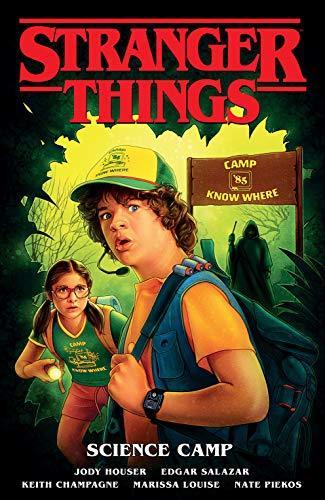
Who knew that when Dustin went to Science Camp, he walked right into a Friday the 13th movie? 😂
Don't want to spoil too much about this one, but I had a blast reading it. Dustin's perspective is always entertaining, the comic works as a brilliant introduction for Suzie, and the mystery plaguing the camp is genuinely interesting and has a good twist. High recommendation.
#4: Stranger Things Zombie Boys (See Review Here)
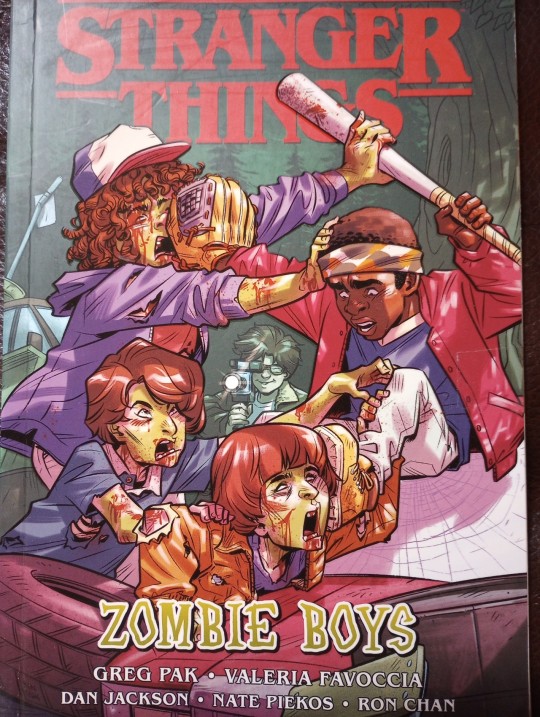
I'm still bitter that the character of Joey Kim never made an appearance on the show despite the camaraderie he had with the Party, as well as how he gave the boys some catharsis from all the shit they were put through in season 1.
Nevertheless, I enjoyed the premise of the Party making a zombie movie, and I appreciated how it handled the characters' trauma without being patronizing. The artwork was also impressive and beautiful to look at. Here's hoping we get more comics and graphic novels like this in the future!
#3: Stranger Things Tomb Of Ybwen (See Review Here)
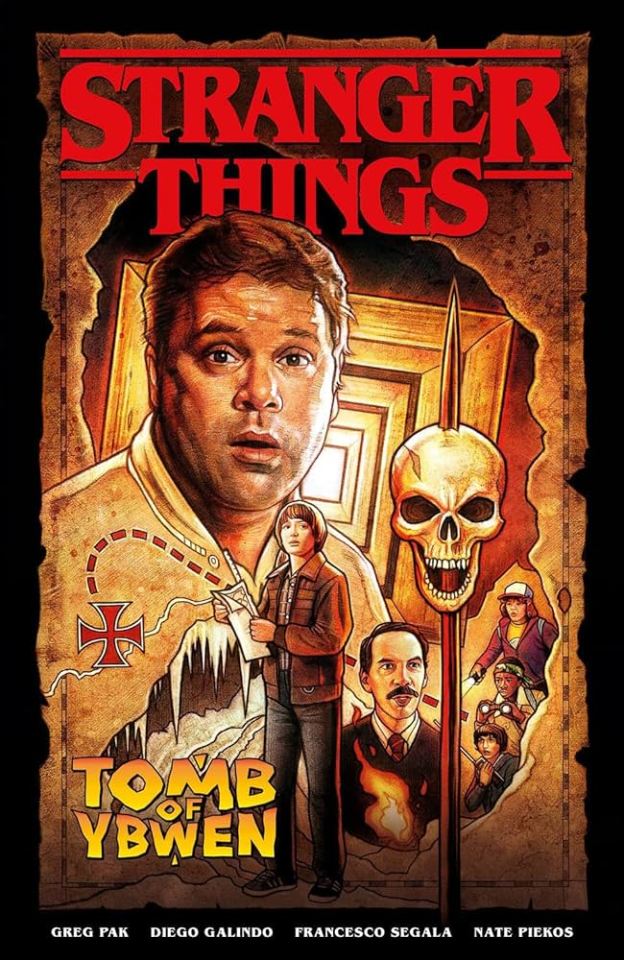
At its core, the comic manages to explore an aspect that wasn't given much coverage on the show: Will's reaction to Bob's death and his attempts to come to terms with it. All of which culminates in a quest Will undertakes when he finds a map from Bob that (allegedly) leads to an ancient Viking treasure buried in Hawkins.
I don't want to give too much away in terms of spoilers, but the story is both emotional, sad, and heartwarming, and it does an excellent job reinforcing the friendship between all 4 boys while also demonstrating the impact Bob had on Will's life.
#2: Stranger Things and Dungeons and Dragons (See Review Here)
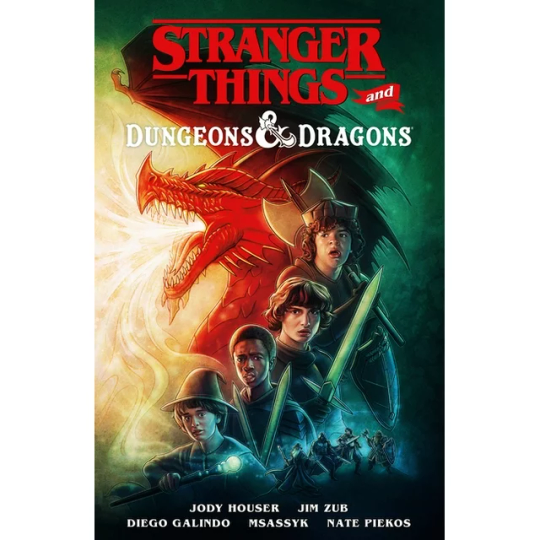
Speaking as someone who's occasionally crafted various fantasy scenarios in my head to cope with the stresses of life, this comic was deeply relatable. The show never shied away from emphasizing the importance of D&D to these characters, and this comic expands on that by illustrating why they became interested in D&D in the first place, how they've used D&D to cope with living in Hawkins, how the events of the first 3 seasons factor into how they play D&D, and how the game evolved with them as they continued to get older. It's like the piece of media from your childhood that stays with you as an adult. Arguably the best comic in the series (so far).
#1: Stranger Things Rebel Robin (See Reviews Here)

My favorite book and tie-in of the series. Speaking as someone who's gay, this story spoke to me on a personal level, and there were a lot of parallels I was drawing between Robin's experiences in high school and my own: The fear of being outed and ostracized. The desire to break free and explore the world. Recognizing the injustices that exist in society and wishing you could do something about them. Getting a nasty dose of reality that people you thought you could trust aren't reliable, and may even be more awful than you anticipated. Been there, done that, still dealing with some aspects of it.
It's funny because even if you take out the plot elements relating to the Upside Down, you still get a great coming-of-age story, and one that speaks to many people, LGBT+ or otherwise.
That concludes the ranking and reviews for right now! Thank you again for those who've been reading them! :)
#stranger things#tgh opinions#tgh reviews#stranger things comics#stranger things tie-in novels#mike wheeler#will byers#dustin henderson#lucas sinclair#el hopper#max mayfield#steve harrington#robin buckley#jonathan byers#nancy wheeler#erica sinclair#eddie munson#kali prasad#bob newby#jim hopper#joyce byers#murray bauman#the duffer brothers#ross duffer#matt duffer
22 notes
·
View notes
Text
Thoughts regarding the Scifos
i felt like gathering some ideas that ive had and discussed with people in the past, combining them with what we have available from the novel translations of dnk. it'll be under cut for if you havent read the novels yet and/or havent finished tov.
this goes without saying, but obviously since this is all found within side content and not in the game directly, this doesnt mean its 100% canon. its only canon to a person if they choose to believe it!
also. this is all speculative so do keep that in mind!
but i want to take note of how much flynn's parents' influence (in the brief time they've spent with flynn) could be felt on him. obviously, this wont be an ideal look at it, as writing and ideas about flynn's parents wasn't a thing in the game, and instead started with the first strike movie (unfortunately, some plot points contradict with things within the game. this is not the post to talk about that though). flynns past is explored further in the novels, which released around 2015/2016
firstly, it would be good to try gather whatever confirmed info there is on flynn's father. flynn's father in dnk doesnt even have a name attached to him! but i decided to stick with the name we get in first strike: finath scifo. for starters, let's stick with only the information from the novels.
it's heavily implied that the scifos all come from the citizen's/public quarter. finath's death was enough of a blow to norein and flynn that they needed to part with their former lives and move to the lower quarter. with how sickly norein is shown to be, it becomes apparent to me that finath was the sole breadwinner of the family. you could argue that he probably wasnt a very important position of a knight too, since becoming a captain is pretty hard. (flynn is the spiders georg of knight promotions) hence, finath probably wasnt even that rich (but still doing fine when compared to the lower quarter residents). if he didnt earn much to begin with, then it would make sense why norein had to resort to selling most of her and flynns possessions and move out.
as to how he must have been as a person... clearly, his own sense of justice affected norein enough for her to wish to follow the same principles, even if it meant her death. the question i want to pose though, how much of his sense of justice can we infer? was he actually against people stealing? how much of his worldview has influenced flynn in the novels?
with how flynn seems to act about the dark wings in the novels, its possible to say yes, finath was against stealing. but even then, i cant find myself saying this with complete certainty. this is because norein makes the choice to not drink the panacea, and it's already been years since finath's death. i feel her memory of finath and the choices she makes must have been motivated by her own mental state, too, besides finath's morals.
when it comes to flynn, finath actually started teaching his son swordsmanship before age 7. historically speaking, trainings for knights in noble families started from age 7, when the child is considered a page, whose job became to serve the senior knight, as well as learning swordsmanship. with flynn even having a book on techniques that he continues learning diligently from, its apparent that finath had ambitions for flynn to follow in his footsteps. i feel i could argue this could also be part of the reason why flynn is so adamant about not besmirching techniques for the knights, and why he chides yuri about it (both in the novels and in the game). by doing the same techniques, it's like flynn is able to honor his father's death, even if knighthood itself is a sore spot for him at the time.
i also want to note the words norein uses in her posthumous letter to flynn: [source from this chapter]
You may not be able to understand the choice he made, or the choice I made, right now. I’m sorry for not being able to stay by your side until you did. Even so, I still hope that you will understand one day.
(emphasis in bold by me)
once again, it all comes back to choices and living (or dying) by them, a central theme of vesperia!
the wording here is fascinating, as we never quite get an explanation as to how finath died in the novels.
but ultimately, it was still a choice he made that lead to his death. norein probably knows how finath must have perished. does flynn? with how dodgy he is on the topic, it could be argued for either way. in my opinion, with how the novels follows flynn's perspective sometimes, it doesnt seem that bit in particular turmoils flynn. it makes me think he is probably aware of how finath died, but simply hasnt been able to fully come to terms with it (much like how he later struggles understanding norein's choice to not drink the panacea)
i feel like such an honesty on how and why both his parents died is a double-edged sword for flynn. while he is able to know the truth, it also makes him close off with his thoughts at his lowest. granted, this isnt fully visible in game, but id argue its one of the possible reasons he spends so much time coming to terms with different things and ruminates about it even when in the party (such as yuri's killings). in fact, in-game, he takes alexei's betrayal pretty badly, still wishing he could understand why alexei made this choice even in the latter's boss fight, much to yuris surprise!
let's move on to norein for now. we know she is sickly, and it's clear that she hasnt been the same since moving to the lower quarter. flynn tends to her on many days, and she requires his help on many things even as he is young. she's made the hat for flynn in the past, but you never find her making anything similar again. if she had any particular interests and passions, finath's death took them with him.
it's when she is able to teach the lower quarter how to read that she briefly regains a spark of life, and a purpose to do something. and when she is hit with the (presumably aer-related) sickness, she sinks back to how she'd been. she refuses the panacea from jiri, because it meant going against finath's ideals, and chose to die.
it's easy to infer that she was an incredibly depressed woman. and when she was hit with such a deadly sickness, i think she was simply waiting to die from it. obviously, it's a painful and a pretty terrible choice to have, especially as she does ultimately leave her son all alone. on the other hand, she believes flynn wouldnt be alone in the community of the lower quarter. its hard to completely rationalize her choice, as it all seems motivated by her own mental state. such as the fact she may also display some form of self-deprecation? how low would one have to be doing to think their child will be ultimately alright after their death?
what does all of this say about flynn later on? you see this as soon as chapter one of the novel. he doesnt wish to be a trouble for, or have his negative feelings be known by his mother. he puts on a smile, and isnt entirely honest with her when the other boys pestered him. he goes for the river escapade for his mother's health's sake, and not for any other known reason.
even when she dies, flynn is never able to get out of that behavior. as is noted in the last chapter for part 2, it's like he had no desire for anything. this was said about him not spending money, but this line seems to ring true about flynn throughout the novel. this is obviously due to the grief he's been dealing with, but it's also indicative of something flynn struggles in the future too. he is never able to be a very selfish person. arguably, when he expresses selfishness, it actually ends up causing some things to go differently (such as when he insists going with the party to baction rather than lead his brigade up until the heracles scenes) (or how, arguably, his own insistence to learn knight techniques evolved into norein willingly teaching literacy to the lower quarter residents)
especially in his position as a knight, taking any time as distraction even to speak to yuri for a bit costs him valuable time. this is already an issue when you become a captain of the knights, but its even further amplified when its an issue flynns been dealing with since childhood.
but when it comes to it, it seems to me that there have been some vague attempts for flynn to stop concerning himself with knighthood, from noreins end. i dont mean it in a "she was against it", but in a "she didnt encourage him" way. for one, flynn didnt have his first sword back for quite some time, until chapter 3 of part 1 in the novels when he and yuri bought it back. so he wasnt able to train with a sword by looking at his manual. and yet, the manual was the single thing flynn had left of knighthood and of his father.
finally, i want to invoke the reason the first strike movie gives for finath's death, and how it may have affected norein and flynn.
(this is incredibly speculative)
the movie says finath "disobeyed orders". for a knight who seems to have had astrong g sense of justice that affected both norein and flynns sense of right and wrong, it makes one wonder:
a) was he truly uptight about morals, and made an exception that resulted in him dying?
b) or was he more lax with strictness, but thebreader is getting a warped sense of his views through norein in the novels? a more back or white reading of his views, as opposed to nuance?
when norein declined the panacea, was that her way of affirming finath's morals when he didnt at his death? was the memory his family has of him sculpted into an ideal, rather than remain that of a person they knew?
we dont even know his name in the novels.
when looking back to the game, flynn is textually treated as the shining light of the imperial knights, and the light to yuris dark. yuri also has, by act 3, put him on a pedestal, undermining the equal standing they otherwise are shown to have in game. because yuri thinks too little of himself as a person, and thinks flynn of more than simply the person he calls his best friend.
and ironically enough, flynn in his youth makes the choice of sticking to knighthood, and ultimately, sticking to his beliefs. in the future, its a path where he has to numb down most of his desires for the sake of following his principles. he unknowingly may have made the choice of sacrificing his selfishness.
for his beliefs, finath had made a choice that resulted in the separation from his family. for her beliefs, norein forgot all that she had to live for, and gave up.
is it for a similar reason that flynn doesnt protest his commandant position? (there are hints that the commandant position broke alexei, after all)
...here is a final thought to chew on in regards to finath. stage play spoiler. its in rot13 cypher:
va gur fgntr cynl, gurer vf n fprar jurer nyrkrv naq sylaa gnyx. va gung fprar, nyrkrv zragvbaf sylaaf sngure, juvpu gryyf gur nhqvrapr gung nyrkrv xarj svangu.
i wouldnt take the bit itself too seriously, as, again, its not something stated in the original source material, but it opens room for speculation, so i figured it can be shared
#not kidding. this is rambly and indulgent on my end#woe tovposting be upon ye#tales of vesperia#flynn scifo
13 notes
·
View notes
Note
Hiii! What have you been up to now that you're done with college? I'm starting my last year in september and already feeling suuper nostalgic
hello! we have an obligatory one year professional internship for clinical practice in pt that we have to look for autonomously so im currently building up my resume and contacting entities that id like to work with (in my case foster care homes and associations that intervene with neurodevelopmental or functional diversity in childhood/adolescence). i loathe the concept of clinical work thats not accessible and i trace my practice towards community so im also trying to contact local orgs that provide therapy work (individual or group) for people who struggle financially and cannot afford it other way.
not really interesting but thats what ive been up 😶. last year of masters in clinical psych for me was especially tiring because we juggle internship w/ thesis (in pt's others master programs normally you either choose to write a thesis or to intern, i dont know if it's the same internationally, but i really struggled combining everything with my part time job) so i didnt get to feel nostalgic. im also preparing my admission to the phd program next year and i never feel like i stray away from academia too long to feel sad about it! i literally have to go back in september because i have an oral communication in an international congress to prepare with my professor and colleagues for october.
besides getting-a-job and academia related stuff, ive been @ the studio making ceramic pieces to sell locally! will post about them when i have the batches done. im also really invested on learning more about linoprinting. im waiting for response to a volunteering opportunity with people who are in the justice system and people who have been released but are alone and need a friend to grab coffee with. ive quit antidepressants (thank you all for your help once again). i havent been reading enough nor doing enough for myself but its a little-by-litte process. burnout fucks you up
i hope you get to enjoy your last year, friend. but also mentally prepare for how lost you feel after finishing a degree because.............. im not gonna even tell you anything. its the blackest hole. on an happier note you can always make learning / teaching your job.. you know 😉
7 notes
·
View notes
Text

IV. The Illusion of Happiness
“And that,” put in the Director sententiously, “that is the secret of happiness and virtue—liking what you’ve got to do. All conditioning aims at that: making people like their unescapable social destiny.”[71] —ALDOUS HUXLEY
“Feeling blue? Doctors now say you can lie yourself into happiness. By creating self-deceptions, no matter how negative [your problem], it can be turned into a positive and you’ll have greater [happiness].”[72] —RADIO ADVERTISEMENT
DAVID COOPERRIDER, a professor from Case Western Reserve University, is a plump, balding man in a shapeless black suit and checkered tie. He stands in the center of the stage in the high-ceilinged lecture hall of Claremont Graduate University before some six hundred people. The spotlight illuminates his head.
“What would it mean to create an entire change theory around strengths?” he asks. Such a theory, he asserts, exists. It is called “Transformational Positivity.” And to understand it, people need to shift their thinking, much like Einstein, whom he quotes as saying, “No problem can be solved from the same level of consciousness that created it. We must learn to see the world anew.”
Positive thinking, which is delivered to the culture in a variety of forms, has its academic equivalent in positive psychology. Cooperrider touts what he calls Transformational Positivity. Transformational Positivity, he says, is the future of organizational change. Optimism can and must become a permanent state of mind. He has designed a corporate workshop that promises to bring about this change. It is called “Appreciative Inquiry.” Appreciative Inquiry, he assures the audience, will spread happiness around the world.
Appreciative Inquiry promises to transform organizations into “Positive Institutions.” “It’s almost like fusion energy,” Cooperrider explains. “Fusion is where two positive atoms come together, and there is an incredible energy that is released.” His clients include the U.S. Navy, Wal-Mart, Hewlett-Packard, United Way, Boeing, the American Red Cross, the Carter Center, and the United Nations.[73] Celebrities such as Goldie Hawn also promote positive psychology, designing workshops and curriculums for children and corporate workers. And Appreciative Inquiry, which is supposed to make workers into a happy, harmonious whole, is advertised as a way to increase profits.
Cooperrider, excited and at times sputtering, stands before a Power-Point demonstration. He slips into obscure and often incomprehensible jargon: “Positive Institutions are organizations, including groups, families, and communities, designed and managed for the elevation and the engagement of signature strengths, the connected and combined magnification of strengths, and ultimately, the coherent cross-level refraction of our highest human strengths outward into society and our world” [emphases are Cooperrider’s]. He compares Appreciative Inquiry to a solar concentrator.
Happiness, Cooperrider explains, is achieved through “a progressive concentration and release of positivity—a ‘concrescence’ or growing together—whereby persons are ‘enlarged,’ and organizational or mutual strengths, resources, and positive-potentials are connected and magnified, where both (person and organization) become agents of the greater good beyond them.
“In other words,” he continues, “institutions can be a vehicle for bringing more courage into the world, for amplifying love in the world, for amplifying temperance and justice, and so on.”
He ends by saying that this generation—presumably his—is the most privileged generation in human history. It is a generation that will channel positive emotions through corporations and spread them throughout the culture. The moral and ethical issues of corporatism, from the toxic assets they may have amassed, to predatory lending, to legislation they may author to destroy regulation and oversight, even to the actual products they may produce, from weapons systems to crushing credit-card debt, appear to be irrelevant. There presumably could have been a “positive” Dutch East Indies Company just as there can be a “positive” Halliburton, J. P. Morgan Chase, Xe (formerly Blackwater), or Raytheon.
Corporate harmony means all quotas can be met. All things are possible. Profits can always increase. All we need is the right attitude. The highest form of personal happiness comes, people like Cooperrider insist, when the corporation thrives. Corporate retreats are built around this idea of merging the self with the corporate collective. They often have the feel, as this conference does, of a religious revival. They are designed to whip up emotions. In their inspirational talks, sports stars, retired military commanders, billionaires, and self-help specialists such as Tony Robbins or Cooperrider claim that the impossible is possible. By thinking about things, by visualizing them, by wanting them, we can make them happen. It is a trick worthy of the con artist “Professor” Harold Hill in The Music Man who insists he can teach children to play instruments by getting them to think about the melody.
The purpose and goals of the corporation are never questioned. To question them, to engage in criticism of the goals of the collective, is to be obstructive and negative. The corporations are the powers that determine identity. The corporations tell us who we are and what we can become. And the corporations offer the only route to personal fulfillment and salvation. If we are not happy there is something wrong with us. Debate and criticism, especially about the goals and structure of the corporation, are condemned as negative and “counterproductive.”
Positive psychology is to the corporate state what eugenics was to the Nazis. Positive psychology—at least, as applied so broadly and unquestioningly to corporate relations—is a quack science. It throws a smokescreen over corporate domination, abuse, and greed. Those who preach it serve the corporate leviathan. They are awash in corporate grants. They are invited to corporate retreats to assure corporate employees that they can find happiness by sublimating their selves into corporate culture. They hold academic conferences. They publish a Journal of Happiness Studies and a World Database of Happiness. And the movement has sought and found academic legitimacy. There are more than a hundred courses on positive psychology available on college campuses. The University of Pennsylvania offers a Masters of Applied Positive Psychology established under the leadership of Martin Seligman, author of Authentic Happiness: Using the New Positive Psychology to Realize Your Potential for Lasting Fulfillment and a former president of the American Psychological Association. The School of Behavioral and Organizational Sciences at Claremont Graduate University offers Ph.D. and M.A. concentrations on what it calls “the Science of Positive Psychology.” Degree programs are also available at the University of East London, the University of Milan, and the National Autonomous University of Mexico in Mexico City.
Dr. Tal D. Ben-Shahar, who wrote Happier: Learn the Secrets to Daily Joy and Lasting Fulfillment, taught hugely popular courses at Harvard University on “Positive Psychology” and “The Psychology of Leadership.” He called himself, when he taught at Harvard, the “Harvard Happiness Professor.”
“There is mounting evidence in the psychological literature showing that focusing on cultivating strengths, optimism, gratitude, and a positive perspective can lead to growth during difficult times,” Ben-Shahar has stated.
Positive Psychology has its own therapy techniques to achieve happiness. It instructs patients to write a letter of gratitude to someone who had been kind to them. Patients are instructed to pen “You at your best” essays in which they are asked “to write about a time when they were at their best and then to reflect on personal strengths displayed in the story.” They are instructed to “review the story once every day for a week and to reflect on the strengths they had identified.” And the professionals argue that their research shows that many of their patients have “last ingly increased happiness and decreased depressive symptoms.”
Ben-Shahar pumps out the catchy slogans and clichés that color all cheap self-improvement schemes. “Learn to fail or fail to learn,” he says, and “not ‘It happened for the best,’ but ‘How can I make the best of what happened?’”
He argues that if a traumatic episode can result in post-traumatic stress disorder, it may be possible to create the opposite phenomenon with a single glorious, ecstatic experience. This could, he says, dramatically change a person’s life for the better.
Those who fail to exhibit positive attitudes, no matter the external reality, are in some ways ill. Their attitudes, like those of recalcitrant Chinese during the Cultural Revolution, need correction. Once we adopt a positive mind, positive things will always happen. This belief, like all the other illusions peddled in the culture, encourages people to flee from reality when reality is frightening or depressing. These academic specialists in “happiness” have formulated the “Law of Attraction.” It argues that we attract the good things in life, whether it is money, relationships, or employment, when we focus on what we desire. The gimmick of visualizing what we want and believing we can achieve it is no different from praying to a god or Jesus who we are told wants to make us wealthy and successful. For those who run into the hard walls of reality, the ideology has the pernicious effect of forcing the victim to blame him or herself for his or her pain or suffering. Abused and battered wives or children, the unemployed, the depressed, the mentally ill, the illiterate, the lonely, those grieving for lost loved ones, those crushed by poverty, the terminally ill, those fighting with addictions, those suffering from trauma, those trapped in menial and poorly paid jobs, those facing foreclosure or bankruptcy because they cannot pay their medical bills, need only overcome their negativity. “I think positive emotions are available to everybody,” says Barbara Frederickson, the Kenan Distinguished Professor of Psychology at the University of North Carolina at Chapel Hill and director of that university’s Positive Emotions and Psychophysiology Lab, in the May 2009 issue of The Sun. She also speaks at the Claremont conference. “There’s been research done with people in slums across the globe and with prostitutes, looking at their well-being and satisfaction with life. The data suggest that positive emotions have less to do with material resources than we might think; it’s really about your attitude and approach to your circumstances.” This flight into self-delusion is no more helpful in solving real problems than alchemy. But it is very effective in keeping people from questioning the structures around them that are responsible for their misery. Positive Psychology gives an academic patina to fantasy.
The conference is filled with people in business attire. At the break, many stand in clusters, holding a coffee in one hand and a pastry in the other.
The university is quiet for a Saturday afternoon. The weather outside is overcast and cold. The browning lawns of Claremont’s Pomona College, dotted with palm trees and oaks, reflect the harshness of the statewide drought. There is a half-moon wall visible from the conference center. “CLOSE THE SCHOOL OF THE AMERICAS” is written in large red letters on the wall. “Dan Eats Chicken Skin” and “Dog Boner To The Rescue!” read other graffiti. “SUCK IT, LIFE” is spray-painted in black. Sections of the wall resemble works by Picasso or Diego Rivera. The largest message is “Vote Obama ’08.” The university buildings, with imitation adobe walls and red clay tile roofs, cluster around the college’s clock tower. The campus has the appearance of a California Spanish mission.
In the auditorium, the round face of Martin Seligman appears in a video on a twenty-foot screen. His gaze is serious. Behind him are disordered bookshelves.
“Welcome to this auspicious occasion,” he says to the attentive, mostly white crowd. A young woman, a student of psychology at California State University at Long Beach, scribbles notes. She underlines auspicious occasion.
Seligman speaks of four endeavors for the movement.
“The first endeavor I call ‘positive physical health,’” Seligman says. “If you think about positive psychology as having argued that positive mental health is something over and above the absence of mental illness. That is,” he clarifies, hammering his desk with every “presence,” “the presence of positive emotion, the presence of flow, the presence of engagement, the presence of meaning, the presence of positive relationships.” Seligman pauses. “Can the same thing be said for physical health?” He believes researchers will find a correlation between these positive mental states and the “real” body.[74]
Seligman announces that twenty $200,000 grants--a dream sum for any researcher—will be given out for “groundbreaking research” in the burgeoning field of positive neuroscience. The goal is to locate where positive emotions originate in the brain.
“Education usually consists of taking young people and teaching them workplace skills.... But there is an epidemic of depression,” he says sadly. His optimistic tone returns: “Would it be possible to have positive education? ... That is, without sacrificing any of the usual skills such as discipline, reading, literacy, numeracy.... Can we build engagement, meaning, positive emotion, good relations in schools?”
Seligman announces that schools in the United States, such as the Knowledge Is Power Program (KIPP) schools in Riverside, California, as well as schools in the United Kingdom and in Australia, are putting his theory into practice. The Geelong Grammar School in Australia is implementing a positive psychology curriculum. Hundreds of teachers there are being taught, in missionary fashion, to “spread the notion of positive education.”
In Authentic Happiness, written in 2002, Seligman argues that authentic happiness can be conditioned and thus taught.
A similar-sounding life of “enjoyment,” “engagement,” and “affiliation” is the engineered temperament of the pliant characters in Aldous Huxley’s Brave New World. There, the protagonist, Bernard Marx, turns in frustration to his girlfriend Lenina:
“Don’t you wish you were free, Lenina?” “I don’t know what you mean. I am free. Free to have the most wonderful time. Everybody’s happy nowadays.” He laughed, “Yes, ‘Everybody’s happy nowadays.’ We have been giving the children that at five. But wouldn’t you like to be free to be happy in some other way, Lenina? In your own way, for example; not in everybody else’s way.” “I don’t know what you mean,” she repeated.[75]
“A typical day is full of anxiety and boredom,” writes Mihály Csíkszentmihályi, who is “the brains behind positive psychology,” according to Seligman. He credits Csíkszentmihályi with adding the concept of “flow” to the movement’s ideas.[76] “Flow experiences provide the flashes of instense living against this dull background.” “Flow” is described by Csíkszentmihályi as a state of “being completely involved in an activity for its own sake. The ego falls away. Time flies. Every action, movement, and thought follows naturally from the previous one, like playing jazz. Your whole being is involved, and you’re using your skills to the utmost.”[77] With enough adjustment, he implies, we could all be making beautiful jazz of our lives.
“People who learn to control inner experience will be able to determine the quality of their lives, which is as close as any of us can come to being happy,” Csíkszentmihályi writes in Flow: The Psychology of Optimal Experience (1990). “There are two main strategies we can adopt to improve the quality of life,” he continues. “The first is to try making external conditions match our goals. The second is to change how we experience external conditions to make them fit our goals better.... We cannot deny the facts of nature, but we should certainly try to improve on them.”
Csíkszentmihályi specializes in “optimizing” human experience. The optimal organization man is fitter, happier, more productive, and less expensive. The optimal worker complains less. He or she obeys more. The optimal worker costs the employer less in health-care expenditures.
Csíkszentmihályi developed the idea of “psychological capital,” or what he terms “paratelics.” When Ed Diener, a professor of psychology at the University of Illinois, measured the world according to Csíkszentmihályi’s paratelic factors, he discovered something so “shocking,” he says, it must be true. These paratelic factors—“I can count on others,” “I feel autonomous,” “I learned something new today,” and “I did what I do best”—are, more than money, corruption, starvation, or abuse, “the best predictors of the positive emotions of nations.”
Diener believes he can measure happiness. He conducted a study that found a correlation between the incomes of undergraduates nineteen years after graduation with their level of cheerfulness.[78] His research also showed that happy people have higher supervisor ratings, higher organizational citizenship, and higher incomes.
The movement embraces self-delusion as psychologically and socially beneficial. It also makes handsome profits peddling it. Seligman, Diener, Shelley Taylor, and a slew of positive psychologists write popular books for, essentially, those who can afford the therapy. It is a trade. Dacher Keltner, a positive psychologist at Berkeley, hosts for-pay motivational workshops that cost $139 for standard registration. Csíkszentmihályi participates in the Annual Positive Psychology Forum, which in 2009 was in Sedona, Arizona, supposedly one of the energy hot spots of the world, for a registration fee of $716.74 per person.
“The effective individual in the face of threat seems to be one who permits the development of illusions, nurtures those illusions, and is ultimately restored by those illusions,” writes Taylor, a psychologist at the University of California at Los Angeles.[79] In 1991 Taylor published a book titled Positive Illusions: Creative Self-Deception and the Healthy Mind, in which she argued that “positive illusions” protect mental and physical health.”[80]
Taylor’s article “Illusion and Well-Being” is a commonly cited resource in positive psychology. She insists that positive illusions have a measurable affect on survival rates among patients with cancer, HIV, and cardiovascular disease or surgery.
Positive illusions, described as “pervasive, enduring, and systematic,” come, Taylor writes, in three types: (1) unrealistically positive views of the self; (2) exaggerated perceptions of personal control; and (3) unrealistic optimism. All of these illusions can, managed the right way, supposedly improve our lives. Illusions are good for people, she says, and therefore, by extension, unadorned reality is negative.
But while Taylor sees positive illusions as tools to ward off dysfunction, stress, and bad health, not everyone agrees. Philosopher David Jopling calls such illusions “life-lies.” He argues that so-called positive illusions may work for a while but collapse when reality becomes too harsh and intrudes on the dream world.
“The deeper and more pervasive an individual’s positive illusions,” writes Jopling, “the greater their effect of diminishing his range of awareness of himself, other people, and the situation confronting him.” Jopling argues that self-deception strategies are reality filters that organize what people understand into self-relevant and self-serving packages. “With the diminishing of the range of awareness comes a corresponding diminishing of the range of responsiveness and openness” to what is real. One’s ability to interact intelligently with all of the world’s real consequences diminishes.
Jopling warns of grave moral consequences for a delusional society. “This means that the range of social, emotional, and personal relations that connect us to others, to the social world, and to our own humanity, are progressively weakened as self-deceptive strategies become progressively entrenched in behavior and thought.”[81]
Psychology has a long history of lending its services to the military and government as well as propaganda industries such as advertising, public relations, and human management. The National Institute of Mental Health, from which many positive psychologists have generous grants, though a public institution, has numerous government, military, and commercial relationships .[82]
Keltner is the author of Born to be Good: The Science of the Meaningful Life. He is also executive editor of The Greater Good, a magazine, and director of The Greater Good Science Center on the Berkeley campus. He teaches a course on happiness at the university and hosts motivational workshops on “building compassion, creating well-being.” He has had his ears rubbed by the Dalai Lama.[83]
Keltner sits in his office in Berkeley’s Tolman Hall. Students wait in the hallway for an appointment. He is dressed in shorts, a polo shirt, and sweatshirt with Berkeley’s blue background with gold stripes.
When asked whether positive psychology could be used for mass coercion, Keltner replies: “As scientists our task is to describe human nature as well as we can. So the motivations of positive psychology are well founded. There are branches of our nervous system that we study in our lab that are really mysteries scientifically. The vagus nerve, oxytocin, parts of the brain that are involved in compassion. That’s our first task, and that’s the scientific motivation of positive psychology. And then cultures and societies and communities take science and push it in a lot of different directions. [Charles] Darwin had a theory about human nature that was very sanguine. He said we are a sympathetic species, we take care of others, we are inherently cooperative, and then [Herbert] Spencer, and social Darwinists, and libertarians pushed it in all sorts of directions, in the service of their versions of public policies.... So you always have to separate science from practice. And you can’t critique the science based on the practices that follow. Nazism was an application of a lot of scientific ideas that have nothing to do with the science.”
The theme of the most recent issue of The Greater Good is “The Psychology of Power.” It exposes in scenario after scenario the true purpose of positive psychology—how to manipulate people to do what you want.
The magazine has an article called “Peaceful Parenting,” in which two practitioners explain “how to turn parent-child conflict into cooperation.” The article begins: “It’s nine o’clock on a school night and twelve-year-old Jessie is absorbed in his favorite video game—until his mother comes into his bedroom and announces it’s bedtime.”
“I don’t want to go to bed!” says Jessie.
“But it’s already past your bedtime,” says Mom, “and you know you have to get your rest.”
“But I’m not tired!”
“Well, you will be in the morning if you don’t go to sleep soon.”
“Shut up!” Jessie yells. “Anyway, you can’t make me go to sleep.”
“Sound familiar?” the article asks. “It does to us.... The conversation might go on in this way until Mom, exhausted and angry, shouts something like ‘I quit! Suit yourself!’”
What parents need to do, says the article, is shift from “using power over kids to using power with them.”
“Peaceful parenting” should go like this:
“You’re having a lot of fun playing now, huh?” asks Mom.
“Yeah,” says Jessie. “And I’m not even tired.”
“So you just want to keep playing until you’re tired?”
“Yeah.”
“It must be frustrating to be asked to stop doing something that’s so much fun when you don’t feel tired.”
“I don’t have time for what I want to do. I just have to come home and do homework.”
“Hmm. It sounds like this time between homework and bedtime is really important to you, and you wish it were longer?”
“Yeah, Mom, I do.”
“Thanks for helping me understand that. You know, I’d like you to have as much time as you want for the things that interest you. At the same time, I’ve also noticed that when you stay up after nine on school nights, you’re tired the next morning. Do you hear what my concern is?”
“Yeah, you want me to get a good night’s sleep.”
“Yes, thanks for hearing that.”
“I just need five more minutes to finish this game. Okay?”
“Okay. I’ll get out your pajamas.”[84]
The pages of The Greater Good are awash in such insincere and coercive techniques. The goal, replicated in the corporate workshops where managers are taught how to speak to employees, is not to communicate but to control.
Richard S. Lazarus, who was a professor of psychology at Berkeley, was disturbed by “the vagueness, the religious tone, and the arrogance with which [the claims of positive psychology] are made.”[85] He saw positive psychology as “populist and intellectually much too easy rather than a set of thoughtful ideas or principles to be respected.” “In my opinion, [positive psychologists] are promoting a kind of religion,” wrote Lazarus, “a vision from on high, which is falsely clothed in a claim to science that never materializes.”
Barbara Frederickson, from the University of North Carolina at Chapel Hill, shows the crowd in the Claremont auditorium a cartoon diagram of a sailboat. She says she has found an exact, “totally scientific,” optimal “positivity” ratio for positive to negative emotions: 3 to 1. The keel of the sailboat, she says, represents the “necessary negative emotions” that are heavy and burdensome and “keep the boat on course and manageable,” while the sail, “having ample and sufficient positivity, is what really allows us to take off. What matters most, I have found, is the ratio of your heartfelt positivity relative to your heart-wrenching negativity,” said Frederickson.
“Why do we need positive emotions to really take off?” she asks. “Because positivity opens us.” On the screen overhead, the image of a blue flower appears. “Now imagine you are this flower, and your petals are drawn tightly around your face. If you could see out at all, it’s just a little speck,” she says mournfully. “You can’t appreciate much of what goes on around you.... But once you feel the warmth of the sun, things begin to change, your leaves begin to soften, your petals loosen and begin to stretch outward, exposing your face”—Frederickson splays her hands open around her face like petals—“and removing your delicate blinders, you see more and more, and your world quite literally expands.
“Now some flowers bloom just once. But others, like these day lilies,” she says, pointing to the slides of the blue and now red flowers, “they close up every evening and they bloom again when they see the sun.... Our minds are like these day lilies. Yet their openness honors momentary shifts in our positivity.” Frederickson pauses. “Positivity is to our minds what the sunlight is to day lilies.”
Christopher Peterson and Nansook Park claim to have found the statistically most important “character strengths” in every society around the world. Peterson and Park stand on opposite sides of the stage. The large screen between them shows a bar graph titled “Adult Character Strengths.”
“We have our adult questionnaire online,” says Peterson. “I think to date it’s been completed by about 1.3 million people. Pretty soon it will be the whole world! But about 100,000 people into this, we simply calculated the more common versus less common character strengths, and we have arranged them here.”
Peterson gestures at the graph.
“What’s interesting is that on the left side are certain strengths that are more common, like kindness, fairness, honesty, gratitude. And, we wonder, and other people have said this, if these might not be the sorts of strengths that are necessary for a viable society? It’s kind of hard to imagine a viable society in which these things are not present.
“Now what I left out is, ‘Who do these data refer to?’ Well, this particular graph is 50,000 Americans. But we subdivided it into all fifty states, and you get the same distribution across the fifty states.”
Peterson chuckles.
“Oh yeah, we also looked at fifty-four other nations, and you get the same distribution across the nations ... I remember we sent it to a journal,” Peterson says confidently, “and the first journal editor rejected it, and he said, ‘You didn’t find anything different, any differences.’”
Peterson comically slaps himself on the head, mugging in mock disbelief.
“I said, ‘We found human nature!’” Peterson throws his arms out. “Isn’t that good enough!?”
Peterson goes on to talk about the less important indicators. “Oh, look what’s on the bottom: Self-regulation—that’s like staying on a diet. That’s why I am hiding behind the podium!” The crowd chuckles.
“Modesty,” he says. “Like, ‘God, we are good researchers!’” The crowd laughs louder. “You get the idea!”
Kim Cameron is dressed in a black suit with a red tie. He is Professor of Management and Organizations at the University of Michigan, where he is co-founder of the Center for Positive Organizational Culture. Cameron has come to talk about how corporations can use positive or “virtuous” practices to improve profits.
“All organizations exist to eliminate deviance,” says Cameron. “The reason we organize is to minimize unexpected, chaotic, unpredictable behavior. Right? Organization exists to eliminate negative deviance. The problem is, it also eliminates positive deviance. We organize, and thereby, by definition, we eliminate positively deviant or extraordinary or spectacular or virtuous behavior.”
Cameron says he shows business executives how happiness, compassion, and goodness can increase profits. Cameron’s clients include Fortune 100 companies, but also small organizations, nonprofits, and county governments. Clients range from the YMCA to the trucking industry. Cameron reminds the audience he is not in it for the money, but for the fulfillment he gets from his work. What matters is feeling good. He sells harmony ideology to corporations.
Most positive psychologists belong to the 148,000-member American Psychological Association (APA), which has lent its services for decades to the military and intelligence communities to research and perfect techniques for interrogation and control. Psychologists working for government agencies in the 1950s and ’60s conducted human experiments and discovered that psychological torture, including sensory and sleep deprivation, was far more disorientating and destructive to the human psyche than crude beatings and physical abuse. They refined psychological techniques to ensure complete emotional breakdowns. Psychologists are the only group of major health-care providers who openly participate in interrogations at military and CIA facilities. The American Psychiatric Association and the American Medical Association have forbidden members to participate in military interrogations. But the APA, despite complaints and resignations by a few of its members, has refused to ban its psychologists from interrogations, including at notorious torture sites such as Guantánamo Bay.
A May 2007 Pentagon report by the inspector general’s office acknowledged that psychologists oversaw the adaptation of the military’s Survive, Evade, Resist, and Escape (SERE) program for use against prisoners. SERE was first designed to replicate torture techniques and help U.S. troops resist Chinese and Soviets interrogators. But, in the hands of army and intelligence psychologists, SERE has been reverse-engineered to break prisoners held in American interrogation centers. The sleep deprivation, lengthy stress positions, complete sensory deprivation, isolation, sexual humiliation, and forced nudity are systematically employed to reduce prisoners to a state of utter helplessness. Many become catatonic. The psychologists monitor the steady deterioration of the prisoner and advise interrogators how to employ techniques to complete the psychological disintegration.
Psychologists, in and out of the government, have learned how to manipulate social behavior. The promotion of collective harmony, under the guise of achieving happiness, is simply another carefully designed mechanism for conformity. Positive psychology is about banishing criticism and molding a group into a weak and malleable unit that will take orders. Personal values, those nurtured by an independent conscience, are gently condemned as antagonistic to harmony and happiness. Those who refuse under group pressure to become harmonious are deemed a drag on the corporate body and, if they cannot be reformed, expunged. Those who are willing to surrender their individuality are granted small rewards doled out by the corporate structure. They can feel, at least until they lose their jobs, that they belong to an important and powerful collective. They can adopt a corporate identity. They feel protected. The greatest fear becomes the fear of disrupting the system, of becoming an impediment to the harmony of the corporate collective. The quest for harmony, which these psychologists understand, lures people into a state of psychological somnambulism.
Berkeley anthropologist Laura Nader argues that most oppressive systems of power, including classical Western colonialism and proponents of globalization, all use the idea of social harmony as a control mechanism. There is a vast difference, Nader points out, between social harmony and harmony ideology, between positivity and being genuinely positive. Nader sees harmony ideology as a concerted assault on democracy. The drive for harmony, Nader argues, always lends itself to covert censorship and self-censorship. The tyranny of harmony, when pushed to the extreme, leads to a life of fantasy that shuts out reality. Nader sees the ideology of harmony as one that has slowly dominated and corrupted the wider culture.
Positive psychology is only the latest incarnation of this assault on community and individualism. A related ideology was lauded by Business Week in the early 1980s as the “New Industrial Relations.”[86] It was touted as a new form of human management. It was also said to be “nicer” than the earlier “scientific management” and social engineering innovations of Henry Ford or Frederick Taylor.[87]
Roberto González, an anthropologist at San Jose State University, spent nine months in 1989 and 1990 as a student engineer at General Motors. He later wrote “Brave New Workplace: Cooperation, Control, and the New Industrial Relations,” a study on corporate work teams and “quality circles.” The goal of such programs, González found, “was to end the adversarial relationship between management and labor through ‘self-managed’ work teams, and in so doing improve the efficiency and psychological ‘health’ of those involved.” He notes that these workplace reform programs have gone by several names, including “the team approach,” “employee participation,” “workplace democracy,” “human capitalism,” and “quality of work life” programs.[88]
During the 1980s American automobile corporations used this tactic of labor-management cooperation to compete with what was seen as the Japanese economic juggernaut. “ ... [T]his can be seen, for example,” González recounts, “in the charts at the Chevrolet Gear and Axle plant in Detroit, which lists the sales figures of various American and Japanese cars. Next to these lists is a sign that reads, ‘You are entering the war zone, Quality and productivity are our weapons.’”[89]
Workers at GM were arranged into “self-managed” “quality circles,” or teams of workers who form an identity. These teams competed with other teams to increase their productivity. “We and they” mentality is reduced and collapses into a collective “we.” Quality circles at GM gave themselves names such as “Joe’s Trouble Shooters,” “Positive Approach,” and “Loose Wires and Stripped Nuts.”[90]
“Any status symbol that ferments class consciousness is removed from the workplace,” noted Robert Ozaki in his book Human Capitalism in an observation of a GM-Toyota plant in California. “There are no parking spaces or toilets reserved for executives. Managers and workers dine in the common cafeteria.... Production workers are called ‘associates’ or ‘technicians’ rather than ‘workers’ or employees.’”[91]
Prestige systems, like those in the military, were employed at the Toyota plant at which Satoshi Kamata worked in the 1970s. He recalled how hats of different colors and stripes were used to distinguish rank: “ ... two green stripes stand for Seasonal Worker; one green stripe, Probationer; one white stripe, Trainee; one red stripe, Minor; a cap without any stripe, Regular Worker; two yellow stripes, Team Chief....”[92] “At the same assembly plant,” González continued, citing Kamata’s book Japan in the Passing Lane: An Insider’s Account of Life in a Japanese Auto Factory, “Good idea suggestions” were elicited from workers, and the number submitted by each worker was posted in the locker room.[93] Similarly, one of Kamata’s closest friends boasted about the number of pieces he could produce in a work day. Production became a source of identity and prestige .[94] Any incident or act that disrupted production was condemned. When a worker in Kamata’s quality circle was injured on the job, all members were forced to wear a “Safety First arm band.” This saw them stigmatized by others in the plant.[95] Low prestige was attached to the arm band. Peer pressure--from a worker’s own team-- formed a strong disincentive for anyone to report a job-related injury to avoid having to wear the arm band.
González in Brave New Workplace described a long and double-edged history of attempts to reconcile workers’ interests with those of corporations. It dated back to the “scientific management” methods of Frederick Taylor, who, in the name of efficiency, “‘streamlined’ assembly plants by conducting time-motion studies of each worker, breaking down each movement into a number of discrete steps, and then reorganizing them in a more efficient sequence by eliminating all unnecessary movements.”[96] This dehumanization led Taylor’s disciples to take another approach. While some conservative followers focused solely on “productivity and efficiency,” liberal “business leaders, bankers, politicians, trade-union leaders, and academic social scientists” during the 1920s “tried to forge a viable corporate order.”[97] They sought to establish a stable corporate state by implementing worker “uplift” programs, such as collective bargaining, profit-sharing, company magazines, insurance, pension plans, safety reform, workmen’s compensation, restricted work hours and the “living wage.” The idea that “better living and working conditions would render him [the worker] more cooperative, loyal, content, and, thus, more efficient and ‘level-headed’ ... also carried over into such aspects of the industrial-betterment movement as gardens, restaurants, clubs, recreational facilities, bands, and medical departments.”[98]
“Since at least a century ago, a number of engineers, businessmen, and scientists realized that technology was no longer the limiting factor of production; now, it was man that could be engineered, and made still more efficient, given the right motivation,” González wrote, quoting from historian David Noble’s book America by Design.[99] “However there are two aspects of today’s industrial relations that are genuinely new: first, the specific psychological techniques used to motivate workers; and, second, the increased number of companies willing to experiment with these techniques.”[100]
Toyota pioneered the new approach. “Toyota City” was built by the corporation to completely encapsulate and control the lives of its employees. “Total control over the social environment is an important component of thought reform programs,” González wrote.[101] “At Toyota City, thousands of young men were housed in military-style dormitories, surrounded by a fence and a guardhouse.” He also describes how, “during the time Kamata wrote his account, visitors—including family members—were not allowed to enter the dorms to visit temporary workers. Roommate assignments often grouped men from the same town together,” because, “according to Kamata, ‘it helps them adjust to the new environment and stay put during the employment period.’”[102]
These techniques were adopted by “U.S. bureaucracies and corporations, such as supermarkets, schools, banks, and government offices, including the Pentagon.”[103] During the 1990s, American and Japanese automakers began pursuing what they called the Southern Strategy. They set up factories modeled on Toyota City in Tennessee, Ohio, Kentucky, and Indiana, where, they believed, a lack of unions and rural insularity made for a fertile environment .[104]
González quotes Kamata’s personal account of Toyota City in the 1970s as an example of how emotional stress and sheer fatigue can create bewildering confusion and despair reminiscent of the experiences of those who are inducted into a cult. “When I come back from work,” Kamata recounts, “I do nothing but sleep. I try not to think about the job; even the thought of it is enough to make me feel sick. Mostly, I feel too tired to think about anything.” Several weeks later, Kamata slips into trancelike states on the assembly line:
[S]ometimes I think of something totally illogical: landscapes with towns I once visited suddenly appear one by one. It’s impossible to concentrate on any one scene.... I’m not myself while I’m on the line.... It often surprises me to look up and suddenly find some strange scene in front of my eyes. In that split second I always wonder where I am. Merely seeing the light come in through a door on the opposite side of the building can bowl me over.... Again, for a few seconds, I’m totally disoriented.[105]
This peer group approach replicates the techniques used in coercive influence and control programs in Communist China, the Soviet Union, and North Korea. In these programs, the target subject “would become emotionally attached to the peer group members, who ‘came to know the target’s personality and history exceedingly well.’”[106]
“ ... [A] prisoner in Communist China would develop a circle of friends among his jailers,” explains González, “who could reward or sanction him according to whether or not his behavior fit their standards. Eventually, his behavior could be conditioned through peer pressure.”[107]
Similar processes occur in the cooperative work groups. Kamata explains: “If Fukuyama, the worker on my right, falls behind, he’ll pull me behind, since I barely keep up with the work myself. Even if Fukuyama finishes his job in time, should I take longer on my job, then the next worker, Takeda, will be pulled out of his position. It takes enormous energy to catch up with the line, and if things go wrong, the line stops.”[108]
Anthropologist Alejandro Lugo, who worked at a maquiladora plant in Ciudad Juárez, Mexico, describes a similar experience. He dropped behind many times in his first few days of work, and writes that “the pressure would be almost unbearable” as members of his work group would shout at him for not keeping up.[109]
When a temporary worker at Toyota City was injured and forced to quit, he told Kamata: “I’d have quit a long time ago. But I came here with Miura, so I can’t let him down.”[110] Reflecting on these statements, Kamata argues that the “work here is so difficult that people try to support and encourage one another, especially the ones who come here together. We feel it’s not fair to drop out and go home alone.”
“Circle leaders often learn a great deal about team members’ personalities and histories, sometimes for the purpose of manipulation,” González writes.
For example, at an assembly plant jointly owned by General Motors and Toyota in Fremont, California, a management handout, entitled “Facts a Group Leader Must Know,” implored team leaders to learn the birthday, marital status, anniversary, number of children, and hobbies of each circle member. Furthermore, “team members are encouraged to help each other deal with personal problems.” At a Toyota plant in Japan, team chiefs even used team members’ birthdays to calculate biorhythm charts, so that an individual’s “bad days” could be anticipated by the quality circle.
At a General Motors plant, 22,000 employees partook in weeklong “family awareness training” aimed at “establishing a family atmosphere within the division,” where managers and workers did interpersonal activities.[111] “One of the exercises worked at developing trust,” González summarized:
Employees were paired up and then one of them was blindfolded and guided by the other. In another exercise, “Johari Window,” the object was to reveal as much about one’s “joys, fears, and needs” as possible—and in so doing, open the “window.” Another exercise, “Hot Seat,” took place on the last day of the training session: “One by one each person sits on the ‘hot seat’ and listens to group members say positive things about him or her. It is hard to say which is the more moving experience—sitting on the ‘hot seat’ or seeing those in the seat moved to tears.”[112]
“A recent scandal in the federal government illustrates the dangers posed by coercion masked as harmony,” González concludes.
In May 1995, a Congressional subcommittee was stunned by the bizarre testimony of many witnesses who told of being “psychologically abused” and subjected to sessions resembling “cult programming” during management and diversity training sessions sponsored by the Federal Aviation Administration. According to witnesses, men were fondling women, blacks and whites were urged to exchange epithets, and co-workers were tied together or disrobed for hours at a time during the weeklong training courses, which the FAA subcontracted to various management consultants. One consultant, Gregory May, received $1.67 million in government contracts. According to some witnesses, May is influenced by a West Coast “guru” who occasionally contacts a 35,000-year-old spirit named Ramtha.[113]
In Britain, coercive persuasion techniques were among the blunt instruments used to undermine the strong shop-stewards organizations in well-organized plants such as Unilever and at Rover in Cowley (in the greater Oxford area), with the promise of “jobs for life.” Many trade union officials were initially seduced by this illusion of corporate and worker harmony. General Motors’ Saturn car was built in plants that adopted the Japanese industrial relations model. This experiment, which soon became very unpopular with workers, lasted until 2004, when the union at the Spring Hill plant in Tennessee challenged the GM management and voted to restore the traditional United Auto Workers’ contract.
Corporatism, aided by positive psychology, relies on several effective coercive persuasion techniques, similar to those often employed by cults, to meld workers into a “happy” collective. It sanctions interpersonal and psychological attacks and lavish praise to destabilize an individual’s sense of self and promote compliance. It uses the coercive pressure of organized peer groups. It applies interpersonal pressure, including attacks on individuality and criticism as a form of negativity, to ensure conformity. It manipulates and controls the totality of the person’s social environment to stabilize modified behavior.
Anthony Vasquez is a student at Berkeley. Sitting on the steps of Berkeley’s Kroeber Hall on a sunny evening, he describes his experience with positive psychology at FedEx Kinko’s, a photocopy and printing store. He has hazel eyes and messy black hair, and he is wearing corduroys and a brown mountaineer jacket. He worked at FedEx Kinko’s for about two years and was “always called negative, a com plainer, and not a team player.”
Vasquez recalls that his store’s slogan was “Yes We Can.” “It meant that if a customer asked us to do a job for them, no matter what it was, we were to say, ‘Yes We Can!’” Posters of the slogan were posted near telephones and around the back room. Corporate auditors would phone the store to make sure employees said, “Yes we can!” to every request. Employees would be punished as a group for failures, and individuals could be fired. Other slogans included, “Winning by engaging the hearts and minds of every team member” and “I promise to make every FedEx experience outstanding.”
Vasquez tells about the scandal that ensued when his trainee, Sam, was fired. The store managers did not announce the dismissal but kept Sam on the schedule to make it appear that Sam was skipping work. The managers then used this as grounds for Sam’s removal. After two weeks and several conversations with Sam, Vasquez wrote “Fired” in pencil under Sam’s name on the schedule. The store managers were outraged. They called Vasquez into the office and reprimanded him with a “Positive Discipline Documentation Form.” He was charged with defacing company property and slandering Sam.
“The document explained how I had made ‘false or malicious statements’ against Sam,” says Vasquez. “I told [the managers] they were being duplicitous and that nothing I wrote had been false or malicious. I told them that if they wanted to make ‘our organization a success, ’ they could start by paying me a fair wage. I went on and on until they both threw their hands in the air and told me to stop being difficult. I told them that I wasn’t the one being difficult. They stared hard at me and said reluctantly, ‘We know.’” Vasquez signed the document and left the office.
“It must have been in 2006, the company was holding another mandatory meeting for ‘team members,’ which is what they call us,” he says. “I went with a couple of co-workers to Fresno, where we met a lot of other employees from various stores in northern California.... [T]he meeting took place in this rented room, and the woman from corporate had all these toys, markers, and candy in the middle of each table. The first thing she had us do was organize ourselves according to duration of employment at the company. While in this line, we had to introduce ourselves and say how long we had been working. The girl on the far end had been hired two months prior; the man on the other had been with the company for almost twenty years.”
Some of his co-workers didn’t like having to reveal that they had spent a lifetime working at FedEx Kinko’s. But the corporate manager tried to muster up corporate pride. “She spun it so hard I felt dizzy,” says Vasquez. “‘Isn’t this wonderful?! We have such a wide range of great team members. This really shows what a great place this is to work, and how you can make a career here!’ she said.”
One man stared at the floor in anger and embarrassment. “[I]f he had said anything, she would have e-mailed his center manager and he would have been written up and probably denied a raise. By the way, raises are twenty-five cents a year.
“The purpose of the meeting was, her euphemisms aside, to push merchandise and services onto customers that they didn’t want. I believe it’s called up-selling. She wanted us to talk about our positive customer service experiences. Most of us struggled with this, as nearly all of our experiences with customers and the company had been extremely negative and stressful. But she was all smiles, no matter what we said, and I noticed she was able to make almost everyone there smile and laugh and have a good time. She used the toys, the candy, the markers, and activities like skits and competitions to get people active and involved with each other. She used the happiness and was able to switch its source from human interaction to the company. You aren’t happy because you are being social, you are happy because you work for the company.
“From my two years at the company, ‘positive psychology’ is a euphemism for ‘spin,’” he adds. “They try to spin their employees so much they can’t tell right from left, and in the process they forget they do the work of three people, have no health insurance, and three-quarters of their paycheck goes to rent.”
Positive psychology, like celebrity culture, the relentless drive to consume, and the diversionary appeals of mass entertainment, feeds off the unhappiness that comes from isolation and the loss of community. The corporate teaching that we can find happiness through conformity to corporate culture is a cruel trick, for it is corporate culture that stokes and feeds the great malaise and disconnect of the culture of illusion.
In The Loss of Happiness in Market Democracies, political scientist Robert Lane writes:
Amidst the satisfaction people feel with their material progress, there is a spirit of unhappiness and depression haunting advanced market democracies throughout the world, a spirit that mocks the idea that markets maximize well-being and the eighteenth-century promise of a right to the pursuit of happiness under benign governments of people’s own choosing. The haunting spirit is manifold: a postwar decline in the United States in people who report themselves as happy, a rising tide in all advanced societies of clinical depression and dysphoria (especially among the young), increasing distrust of each other and of political and other institutions, declining belief that the lot of the average man is getting better ... a tragic erosion of family solidarity and community integration together with an apparent decline in warm, intimate relations among friends.[114]
There is a dark, insidious quality to the ideology promoted by the positive psychologists. They condemn all social critics and iconoclasts, the dissidents and individualists, for failing to surrender and seek fulfillment in the collective lowing of the corporate herd. They strangle creativity and moral autonomy. They seek to mold and shape individual human beings into a compliant collective. The primary teaching of this movement, which reflects the ideology of the corporate state, is that fulfillment is to be found in complete and total social conformity, a conformity that all totalitarian and authoritarian structures seek to impose on those they dominate. Its false promise of harmony and happiness only increases internal anxiety and feelings of inadequacy. The nagging undercurrents of alienation and the constant pressure to exhibit a false enthusiasm and buoyancy destroy real relationships. The loneliness of a work life where self-presentation is valued over authenticity and one must always be upbeat and positive, no matter what one’s actual mood or situation, is disorienting and stressful. The awful feeling that being positive may not, in fact, work if one is laid off or becomes sick must be buried and suppressed. Here, in the land of happy thoughts, there are no gross injustices, no abuses of authority, no economic and political systems to challenge, and no reason to complain. Here, we are all happy.
#capitalism#culture#illusion#literacy#the spectacle#United States of America#us politics#tiktok#community building#practical anarchism#anarchist society#practical#mutual aid#grassroots#organization#anarchism#resistance#autonomy#revolution#anarchy#daily posts#communism#anti capitalist#anti capitalism#late stage capitalism#grass roots#anarchists#libraries#leftism#social issues
3 notes
·
View notes
Note
hi almandine ! i hope ur having a wonderful day ; are u taking breaks and eating well ? idk if the semesters are as long as they are for me bc i know we live in different places, but i wish u so much good luck for ur studies as the end of the academic year approaches 🫶 i wanted to ask, what kind of person is leon? what does he do, whats the world he lives in like, and how do u see him thru ur eyes? my only exposure to him is through .. online mods and gifs ive seen of him go viral, u probably know the ones LOL, but i wanted to learn abt him from u if thats okay 🫶 (@dmclr)
Our semester has pretty much come to its conclusion — my first final is in…. 18 days? Just a little over two weeks, which is a terrifying thought. I’ve been trying to see to my needs and give myself a break and here though! <3 I just hope you’ve been taking care of yourself the same way? Please don’t let yourself drown in academic or other stressors, and know that with as strong as you are, you can overcome anything.
The online mods…. Yeah, I’ve. seen a couple. They’re, something certainly. (My reaction to that information v)

What does he do? Well, he was a cop— just started his job, actually (like one day? literally one day? It was the first day?), but then pretty much got hired by The President and got employment as a government agent for the United States. Fun.
The Resident Evil world is… interesting? Kind of like if, “fuck around and find out” and, “instead of asking if you can, ask if you should” combined. There’s biological weapons running rampant, including dogs, literal zombies (but we don’t call them zombies, no), and uh…. Huge grey men?
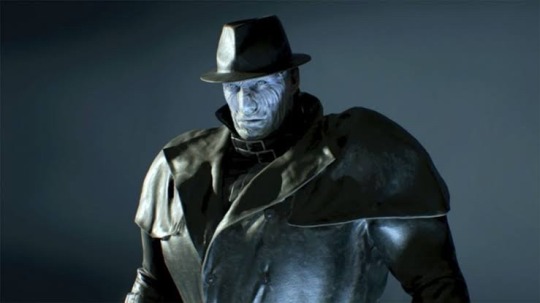
Say hi to him. He will not die. You cannot kill him. You cannot kill anything in this stupid universe actually. My favourite Resident Evil game, Resident Evil 7 (which… ironically doesn’t have Leon in it) literally features this one stupid fucking Southern family (whom I love so sweetly) and the father, Jack Baker, just will. Not. Die. You know how in games you get to experience different boss battles? Yes, well, I don’t remember how many boss battles are in RE7, but I will tell you this: 3 of them belong to Mr. Baker ENTIRELY. He just mutates worse and worse and you keep thinking he is dead but he is NOT. You kill his wife and she dies but no, he just won’t fucking die. And then you buy the DLC and you play as the big, strong, veteran uncle who just PUNCHES THINGS INSTEAD OF USING WEAPONS AND IT SOMEHOW FUCKING WORKS and guess who the big bad is! You’ll never guess! You’ll never figure it out! That’s right! It’s Jack Fucking Baker for the fourth god damn time and now he looks even more disgusting and corrupted. Although the game did not include Leon (it held Ethan Winters, a darling father), it’s still set in the same universe so I feel like you can get a pretty good… idea from all of that, yes? Remember ! Nothing. Dies. If you think it’s dead, it is not, it is simply now More aware of your existence.
Now, onto the actual man himself.
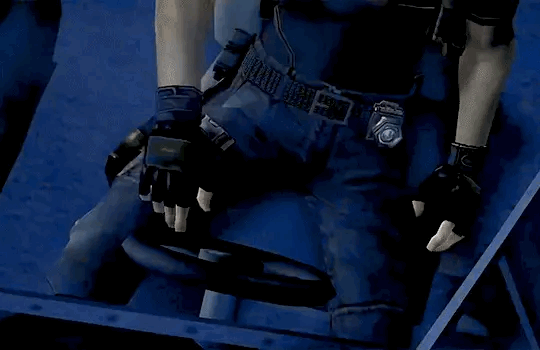
First of all? Not related to my view on him but he’s was… kind of misogyny-coded in the original Resident Evil 4 and that makes me giggle a little but I still somehow prefer that RE4 to the 2023 Remake. I know I reblog gifs of the remake a lot and that is simply because, I mean, who doesn’t enjoy experiencing their silly guy with better graphic quality, right? But I don’t like the alterations they did to certain scenes and dialogues. Also he looked like this in the original re4 which scares me more than the undying mutated abominations so, I. Well.
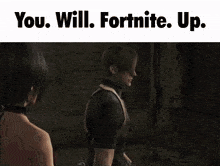
(^ NOT RELATED TO THE MISOGYNY HE WAS SUFFERING FROM DISEASE HE WAS ILL)
Okay, okay, anyway…. I HATE how the fandom views him, it stresses me out. They view him as this demanding, super serious, violent, brooding man who just wants a stupid, ditzy, useless girlfriend he can dominate, control and be a creep towards but that’s… not him? Like, how do you mess up so bad. This isn’t a particular part of the fandom as much almost the majority of it, sadly.
I feel like he’d, if anything, be a “wife guy”; he has a stressful job, he is traumatised beyond belief, he looks death in the eyes on a regular basis, he lost his parents when he was young, he has went through a-lot. And yet he’s so gentle, he still believes in saving everyone. He still believes in humanity and has this hope in him. He is still… soft. I don’t think he’d be a controlling or aggressive partner; I think he just wants something comforting to come back to, and he’d be SO grateful to have a partner who sticks by him through thick or thin, he’d be so genuinely giddy while taking about them. He lost his parents for fuck’s sake and got stuck in this godforsaken infected world when he was just 21… he wants home, I think more than anything he wants to come back to a place where he doesn’t have to think, where things can be handled for him and all he has to do is let himself be loved. Praised and acknowledged for once in his (somewhat miserable, let’s be honest) life. I mentioned, while answering Lucy’s ask, that I view him as a guard dog, and I think that’s perfect for him. He exists to protect — he has dedicated himself to that protection, to offering that canopy. His aggression is never on the offence, it has never been; not once, but it is done as a protective measure. If the years have reduced Ajax to a sword then they have reduced Leon to a shield. He just wants his efforts acknowledged — he just wants praise and warmth and comfort — and yet are they ever? At-least, to the degree they deserve? He falls into a depressive state in Resident Evil: Vendetta and it stings. He is such a simple man and I genuinely believe domesticity could fix him. He has never known what it’s like to feel safe — why would anyone want to force him to be a protector even in his partnership, even in intimacy? Let him relax for fuck’s sake. Let him. know what it’s like to be on the other end for once in his life. Comfortable clothes, hand holding on a warm cup of tea rather than a gun or a knife. No news channels and no social media or nothing. Phone on DND. I do not care if the USA burns to the ground, I want him to rest his head on my shoulder and finally get the sleep he hasn’t had in years. Civilian lives can wait a few hours to be saved.
7 notes
·
View notes